Do you want to know everything there is around Amazon Best Sellers Rank (BSR)?
You are in the right place.
In this guide, you’ll find out what Amazon BSR is, why it is important, as well as discover 24 more ranking factors that affect organic rankings on Amazon.
So if you want to increase your Amazon sales, get high rankings and stand out among other Amazon sellers, you’ll need this guide.
Let’s dive right into it.
Table of Contents
Chapter 1: Amazon’s Algorithm
If you want to know how to improve your sales ranking on Amazon organic search, you’ve got to start with the basics.
Amazon’s algorithm was initially called A9, and it was responsible for ranking products in the Amazon marketplace.
This algorithm is essentially what organizes product research on Amazon.
When you type something like “Yoga Mat” on Amazon’s search bar, it’s the algorithm that decides what you are going to see next.
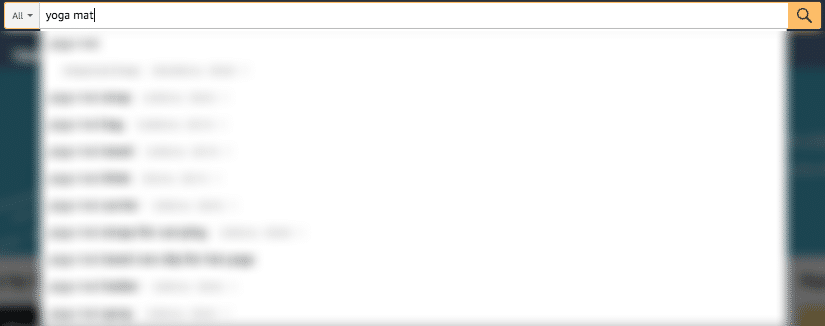
Image Source: Amazon
When you type something like “Yoga Mat” on Amazon’s search bar, it’s the algorithm that decides what you are going to see next.
Before we delve any further, I need you to keep one thing in mind: The Amazon Best Seller Rank is only one of the factors affecting Amazon’s algorithm.
In other words, the algorithm is not one-dimensional, as it is affected by several ranking factors.
According to a 2019 article by the Wall Street Journal:
When people are searching for products on Amazon, nearly two-thirds of all product clicks come from the first page of results.
This means that if you want your product listing to be visible in the Amazon rankings, you have to be on the first page.
Otherwise, you’ll end up on the second page, fighting for (roughly) one-third of the product clicks.
According to a 2018 report by Jumpshot, from 2015 to 2018, Amazon surpassed Google in product searches.
The eCommerce giant—which now has over 80% market share in many product categories—now powers 54% of all product searches.
This means two things:
- Most people seem to trust Amazon for product research
- Ranking in the Amazon marketplace will become much more difficult
Also, you’ve got to keep in mind that 87% of shoppers nowadays begin their product research online, which means that the growth for Amazon’s search engine is not going to slow anytime soon.
Let’s get back to Amazon’s algorithm.
According to Marc Delingat, Director of Core Search on Amazon:
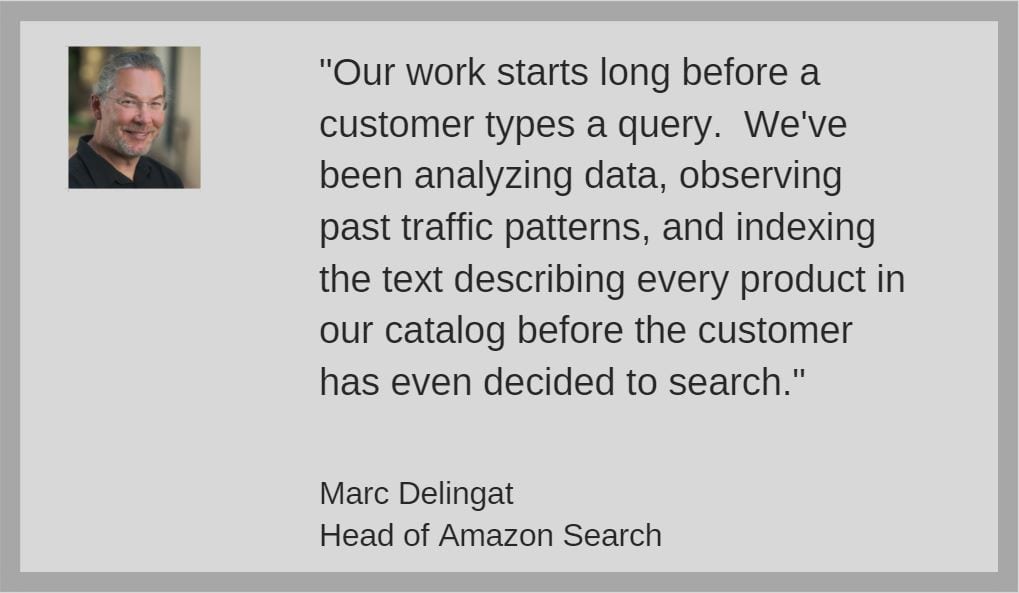
Source: Archive.org
This means that the algorithm ranks Amazon products long before the user types in a search query.
The question, of course, is what makes a product page better than another one so that it ranks higher on the Amazon marketplace.
As per Delingat:
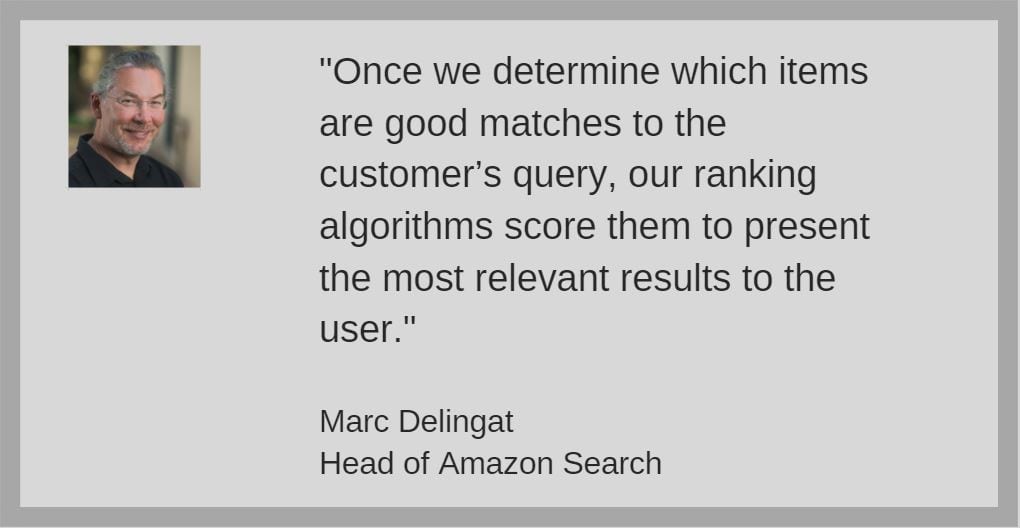
Source: Archive.org
Thus, as it is evident, the algorithm works in two simple parts:
- Pull all the relevant product listings from Amazon’s product catalog
- Sort and deliver the most relevant results to the user
Amazon’s algorithm was up until recently called Amazon A9.
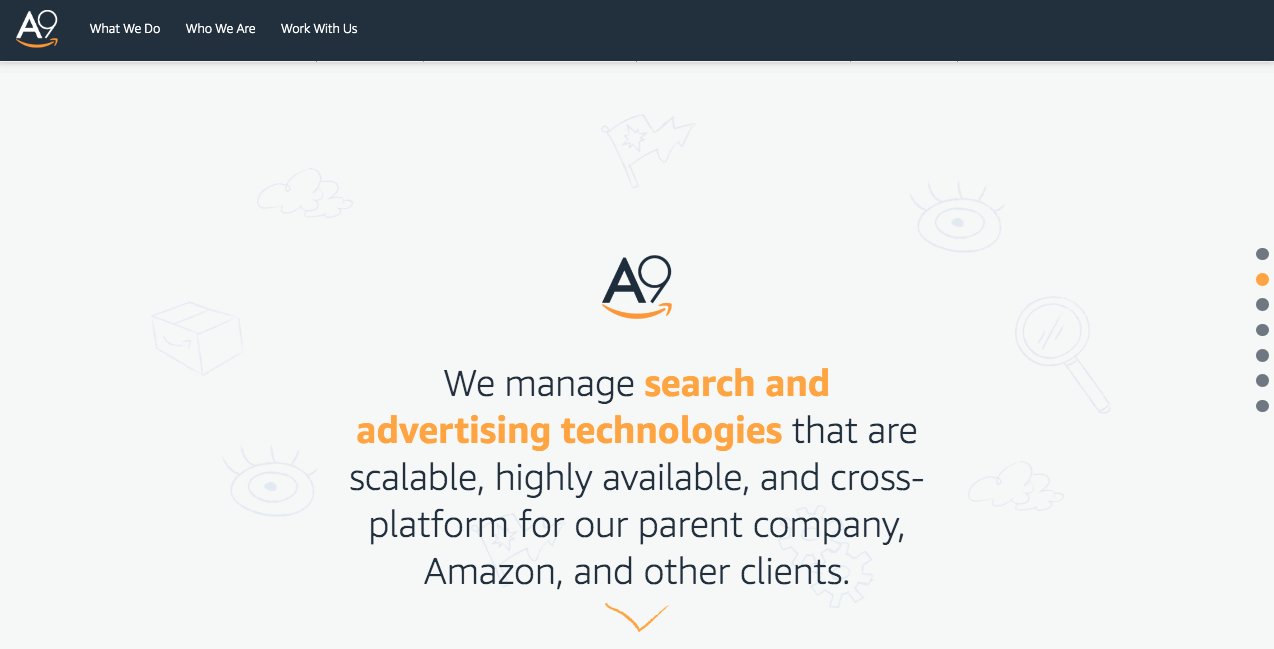
Image Source: Archive.org
According to Wikipedia, A9 was created back in 2003 as “an independent company aimed at producing technology for search and advertising.”
A9 was a subsidiary of Amazon that developed search engine and search advertising technology.
As you can see, Amazon A9 used to handle 1.2 billion ad requests and 45 million visual search queries per day.
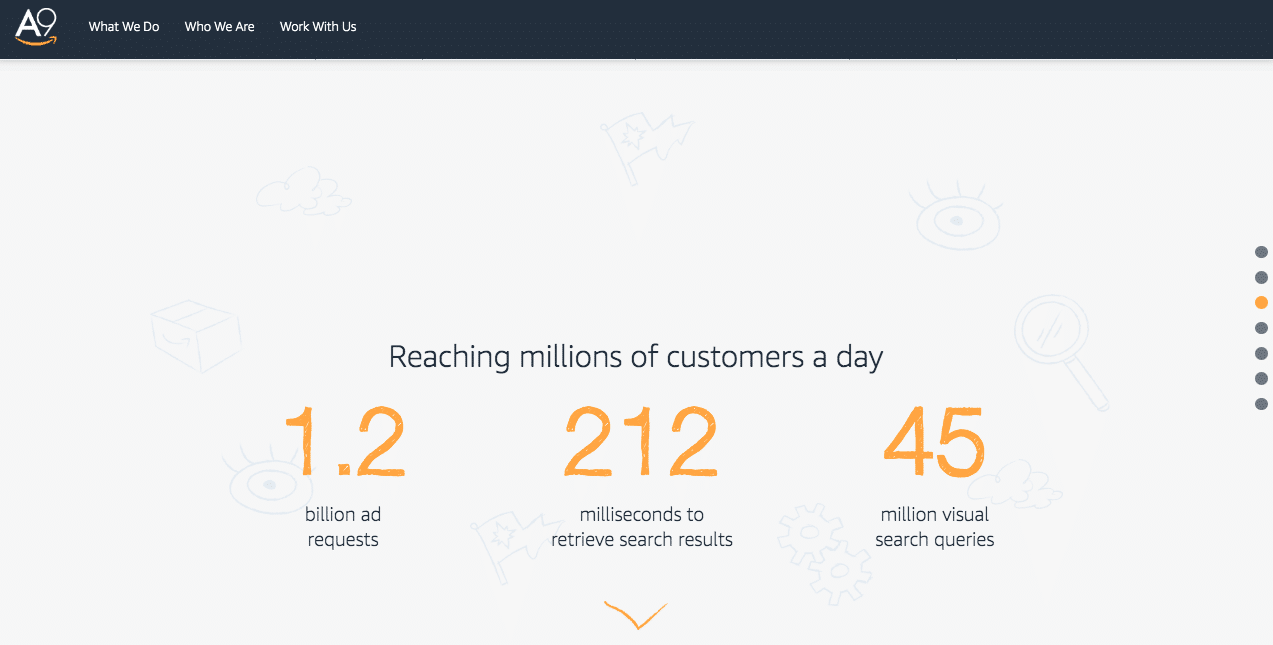
Image Source: Archive.org
A9 has three main areas of focus:
- Product Search
- Visual Search
- Advertising
According to A9’s website, Product Search is the mechanism that returns search results (product pages) when a visitor makes a search on Amazon.
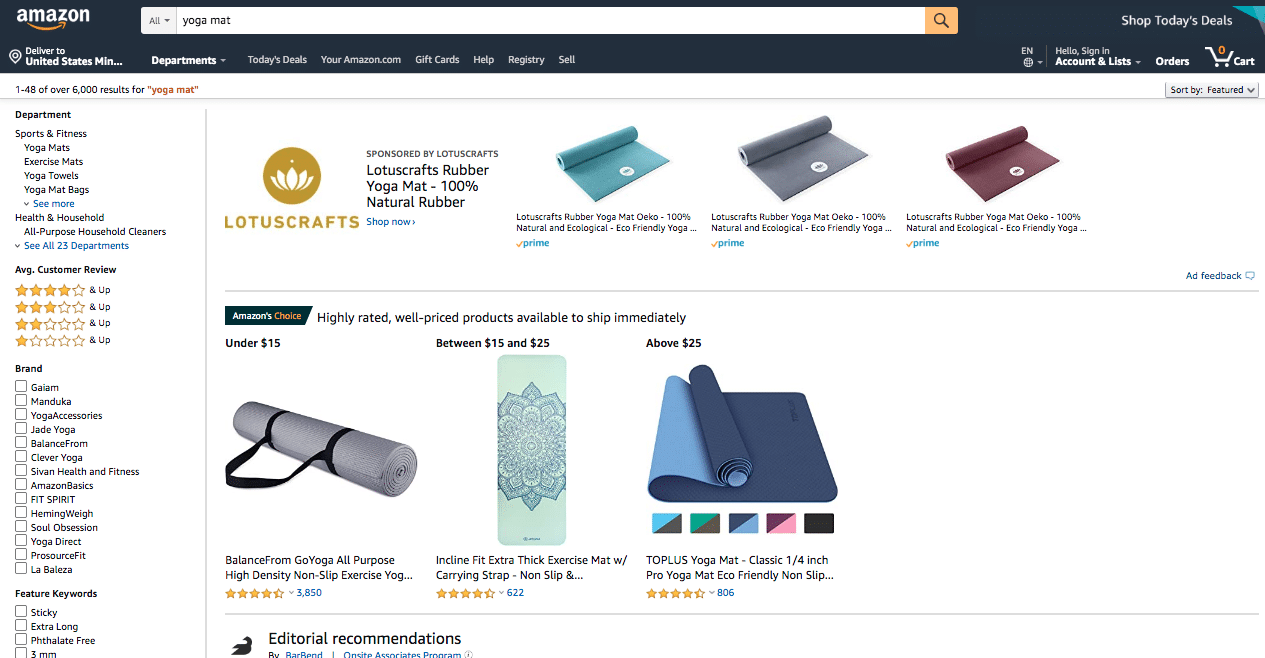
Image Source: Amazon
Visual Search, according to A9’s website, has a different role:
Deep learning-based computer vision solutions that help our customers use visual information to search and discover the world around them.
Visual Search includes applications like Augmented Reality, image matching, and geospatial recognition.
The last of the three areas—Advertising—had as its purpose to “build advertising products and ad-serving systems that handle billions of queries every day.”
Amazon is always trying to improve its algorithm so that it maximizes the value for the visitor.
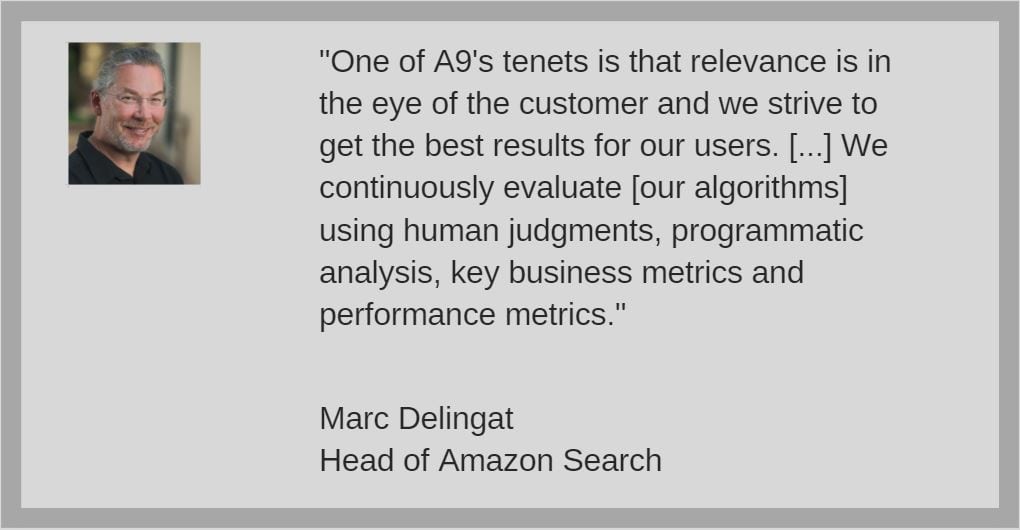
Source: Archive.org
What is interesting is that in 2019, Amazon updated its algorithm and at the same time closed the website A9.com, which was the website of the team behind Amazon search.
According to a 2019 article by The Wall Street Journal, this update in the algorithm boosts Amazon’s own products, instead of treating all products in the Amazon marketplace as equal.
The article mentions that the updated algorithm is using future profitability as a ranking factor—something that we don’t know for sure.
However, Amazon has denied that Amazon’s ranking algorithm takes into consideration long-term profitability.
Amazon’s A9 algorithm works using two very simple goals:
- Give back to the users the most relevant results
- Give back Amazon listings that the user is more likely to buy
Based on those two goals, we can understand that:
- Amazon’s top goal in everything they do is always maximize Revenue Per Customer (RPC)
- Amazon tracks every action that the user takes on Amazon, from the categories they visit, right down to where their mouse hovers on the page
Of course, “relevancy” here is slightly different than in other search engines (i.e. Google).
When you are searching for the term “red laces” on Google…
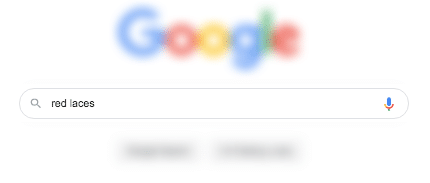
You’ll get results that are relevant to the search term…
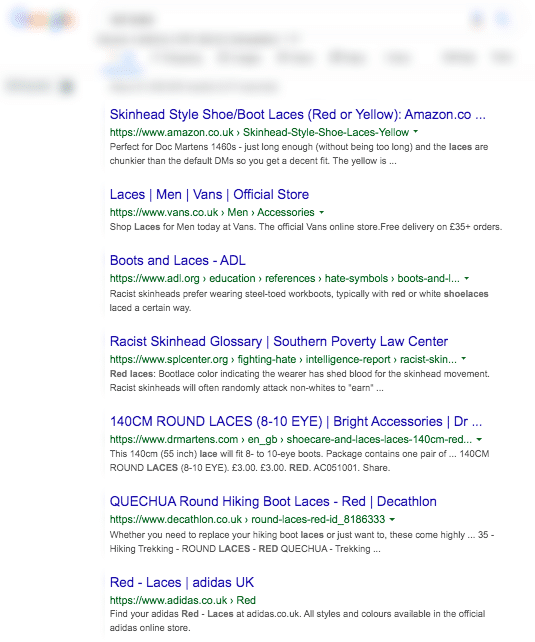
While on Amazon, you’ll get back results that are both relevant, and that may lead to a sale.
We can say that ranking on Google is way more difficult than ranking on Amazon.
With Google, you have to worry about things such as on-page SEO, technical SEO, content, or backlinks.
These are things that you don’t have to worry about when it comes to Amazon SEO.
So if you don’t have to worry about these things, what do you have to worry about?
This is what we are doing to cover in the next chapter.
For now, let me give you the three factors that influence the Amazon ranking algorithm for a new product or an existing one.
What influences the Amazon ranking algorithm?
1) Conversion Rate
These are ranking factors that Amazon found to have a statistically relevant effect on conversion rates. Examples of conversion rate factors include product reviews, meeting the Amazon image requirements and pricing.
2) Relevancy
These are ranking factors that Amazon uses to consider if a product page is relevant to a certain search term. Relevancy factors include your title and product description.
2) Customer Satisfaction
How do you make the most money from a single customer? Make them so happy that they keep coming back. Amazon knows that the secret to max RPC lies in customer retention. It’s a lot harder to get someone to spend $100 once than $10 ten times. Customer Retention ranking factors include seller feedback and Order Defect Rate.
→ Check Out the Best Software & Tools for Amazon Sellers ←
Author’s Note: Amazon uses both predicted and real conversion rates for product rankings. For example, if your product is priced higher than other similar items, Amazon will predict a lower conversion rate for your listing and use that rate until real data corrects it.
You now know almost everything there is about Amazon’s ranking algorithm.
Now, it’s time to start deploying how Amazon sales really happen, by taking a deep dive into a product’s BSR, the sales rank and other ranking factors that Amazon sellers need to be aware of.
Extra Tip: For a complete training around Amazon FBA, make sure to take a look at our complete Amazon course.
Chapter 2: Top 25 Amazon Ranking Factors
At this point, I am going to show you some of the most critical Amazon ranking factors.
According to some unconfirmed sources, there may be less than 25 ranking factors.
However, as with Google, we are not able to know for sure what makes product listing go up in the Amazon search results.
Of course, Amazon is more open than Google, but still, you can’t be 100% sure about the factors that affect the search results.
Can product details, recent sales, term relevancy, historical sales data, sales volume of the product or even future sales, be some of the factors that Amazon is using to rank products on the marketplace?
Let’s see what the top ranking factors for each of the three categories that I shared with you earlier.
→ 20 Amazon Seller Forums to Help You Succeed with Amazon FBA ←
Conversion Rate Ranking Factors
1. Sales Rank
So let’s start with one of the most critical Amazon ranking factors.
What is the Amazon sales ranking?
The Amazon Sales Rank is one of the most critical ranking factors for Amazon. It counts the sales that a product has as a way to determine its position in the Amazon search results page.
Simply put, the number of historical sales compared to other products can make a product rank higher on Amazon’s results page.
For example, take a look at the following results for the term “mixer:”
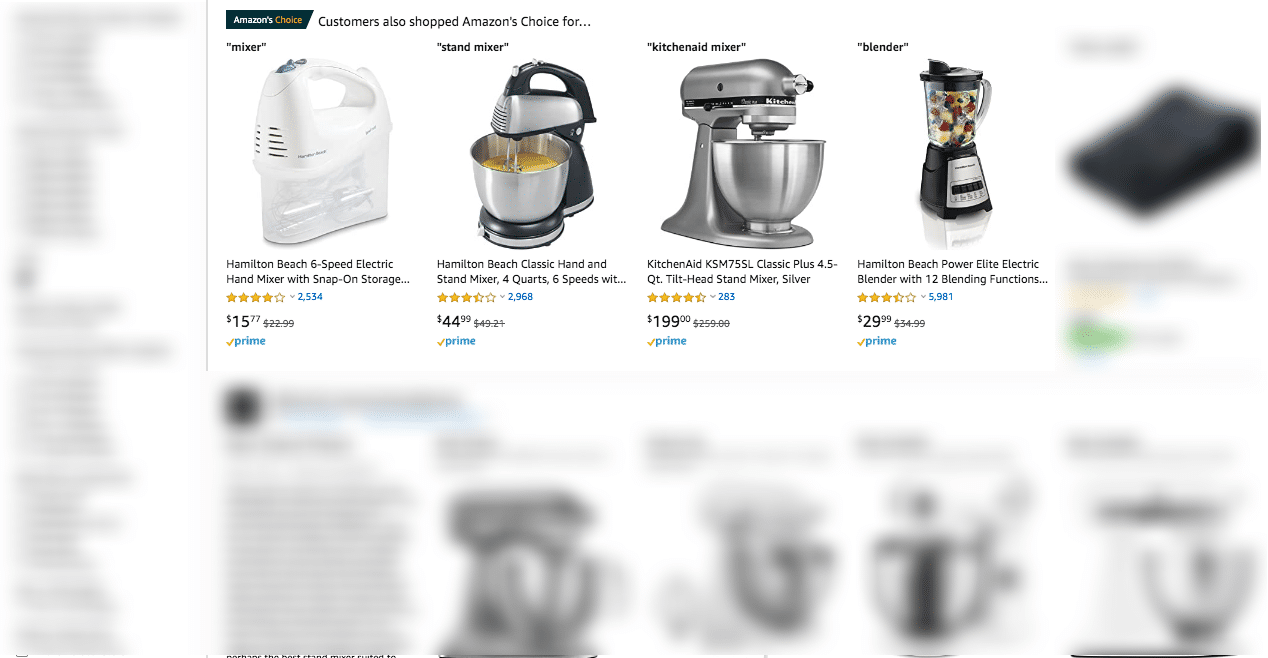
Image Source: Amazon
If you see the results ranking at the top (below Sponsored Products), you’ll notice that they all have many reviews.
In fact, three of them have over 2,000 product reviews each.
This shows us that thousands of people have bought these products.
And, more sales on Amazon mean higher rankings, which result in even more sales.
What is a good sales ranking on Amazon?
The truth is that there isn’t a good sales ranking on Amazon. The higher the sales rank, the better. And, to achieve that, you need more sales and more happy customers for your products.
Now, you may say that this is not fair for new products entering Amazon.
Unfortunately, no one said it would be.
But, let’s dive a bit deeper to see what Amazon best sellers rank is all about.
If you visit a product page and scroll down until you find the product details, you’ll find a small field that is called “Best Sellers Rank.”

Image Source: Amazon
This number essentially tells you how this product ranks for category-specific searches.
For example, for a category-specific product search for “strollers,” you’ll get a list of results where some of them will have the following banner in the left corner of the product listing:
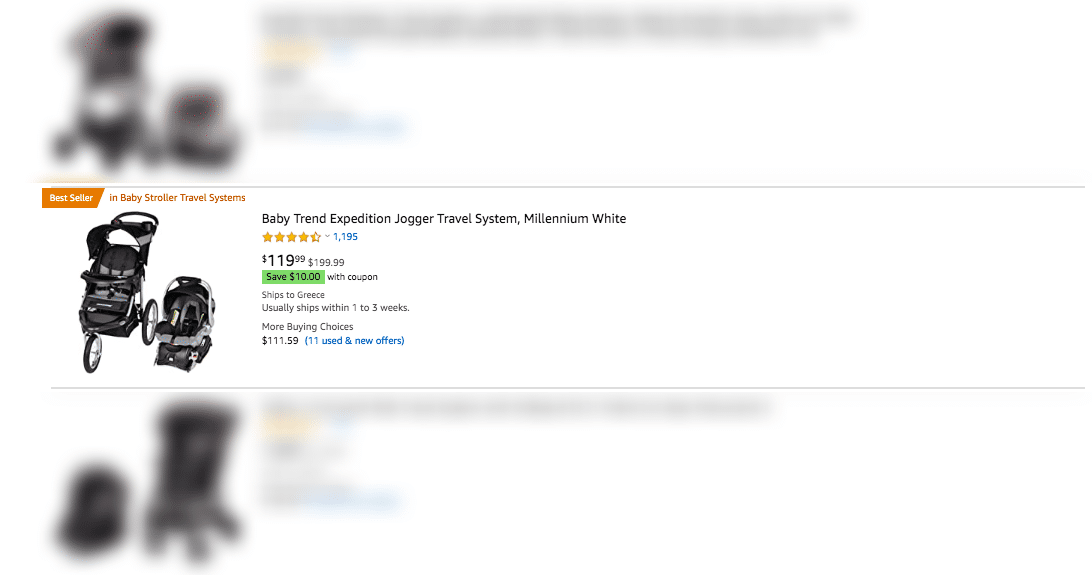
Image Source: Amazon
Except for showing your product page higher, this BSR banner makes your “real estate” in the Amazon results page more interesting.
How to increase Amazon ranking?
Increasing your Amazon ranking is something that is affected by many parameters. This means that the Amazon seller rank is not the only factor that affects your rankings. Overall, you want to offer an excellent experience for your customers.
This means that becoming a best-seller is not only a matter of the number of sales.
Your product has to be AWESOME; you have to have great customer support and offer an overall great experience.
But, rest assured that the Amazon best sellers rank can (and will) affect your sales.
If you visit the best selling products for any category, you’ll see that Amazon indeed takes into account the number of sales for ranking these products.

Image Source: Amazon
However, it is critical to understand that a high number of sales by itself means nothing.
If you want to have a high sales rank, you need to provide a great experience overall for your customers.
Do that, and after a while, you’ll see your BSR going up.
Let’s move on to the next ranking factor.
2. Product Reviews
The number of product reviews for a given product is another critical ranking factor.
If you want to know how Airtame managed to increase its sales by getting more positive reviews on Amazon, make sure to take a look at the following case study:
→ How Amazon Reviews Increased Our Sales Dramatically in 9 Months ←
When selling on Amazon, you shouldn’t expect all your product reviews to be positive.
Having said that, how you respond to those reviews matters as well.
This example product search for the keyword “vacuum” illustrates some interesting points about how Amazon weights review volume vs. review quality:
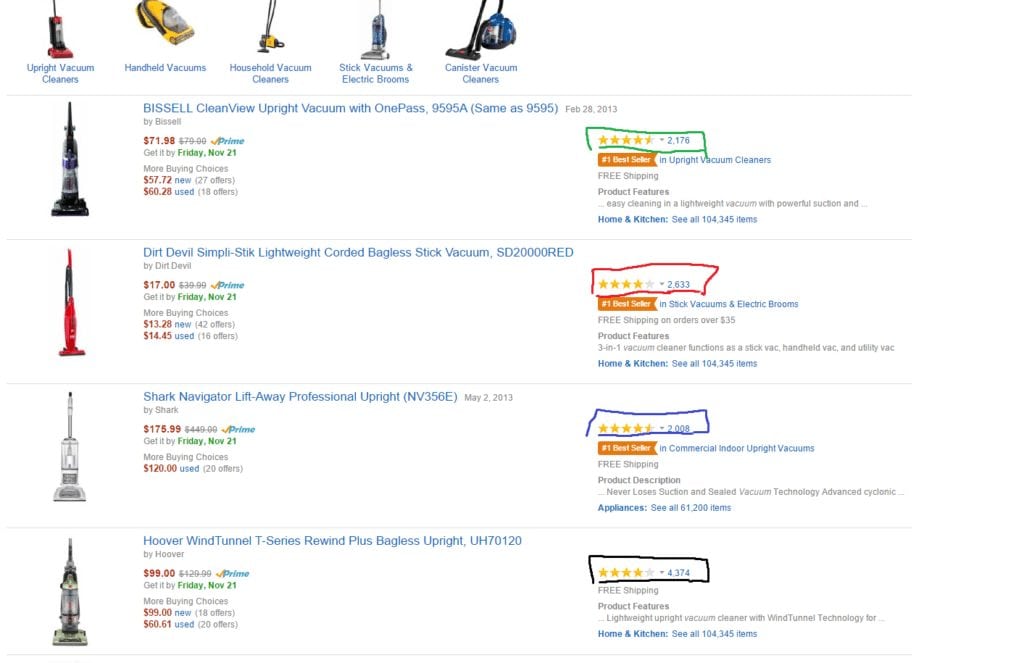
Let’s dissect this search results page:
- The BISSEL vacuum (green) has the most reviews AND the highest review rating. It’s also the best-seller in its category, so it ranks at the top.
- The second-ranked Dirt Devil (red) has more reviews, but a lower review rating. It’s also a best-seller, so it ranks second.
- The third-ranked Shark Navigator (blue) has fewer reviews, but a higher rating than #2, and it’s also a best-seller, so it ranks #3.
- The Hoover WindTunnel at #4 has substantially more reviews than any of the top three listings, but it’s not as highly rated as #1 and #3, and it’s not a best-seller, so it ranks #4.
Let’s move on to the next ranking factor.
3. Answered Questions
The number of Answered Questions—even though not a direct ranking factor—definitely affect conversions, since it is located at the top of the product page.
Usually, the higher the number of Answered Questions, the best.
For example, if you take a look at the following Amazon listing for a vacuum cleaner, you’ll notice that besides having many product reviews, this product also has almost 500 answered questions.
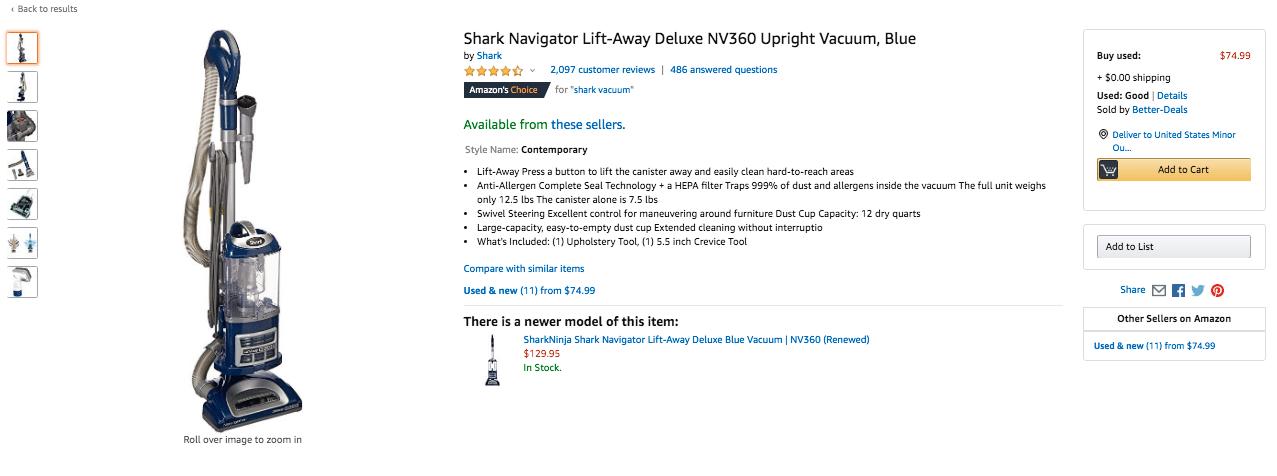
Image Source: Amazon
This is one of the reasons why it is ranking high for the term “vacuum,” which is a popular term.
Also, apart from affecting Amazon rankings, Answered Questions usually show that there is a community around a product, which is also good for social proof.
4. Image Size & Quality
Image size and quality is another factor that indirectly affects rankings.
If you visit the pages of best selling products, you’ll notice that most of them have high-quality images with the ability to zoom in and take a closer look at the product.
In fact, Amazon continues to tighten its image size and quality policies for product listings.
Right now, some categories won’t even display results that don’t have at least one image that is 1000×1000 pixels or larger. (These are called “suppressed listings.”)
The 1000×1000 pixel image size allows Amazon to offer customers their Hover-to-Zoom feature, shown below, which they’ve found has a dramatic effect on conversion rates.
For example, take a look at the Tippmann Cronus Tactical Marker.
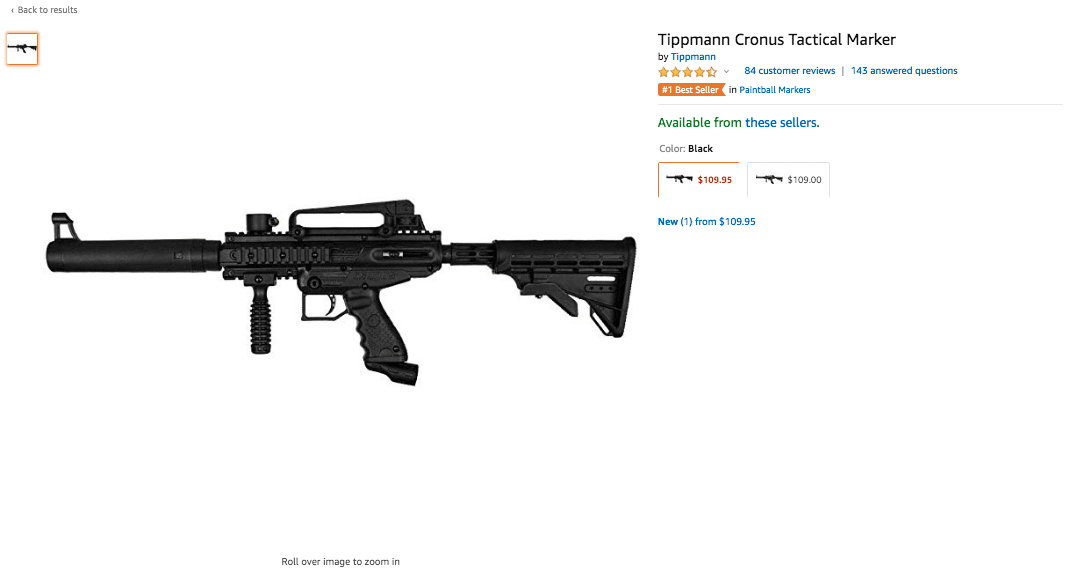
Image Source: Amazon
This product is #1 Best Seller in Paintball Markers with only product image.
If you take a closer look at this image though, you’ll notice that it’s super clear and in-depth.
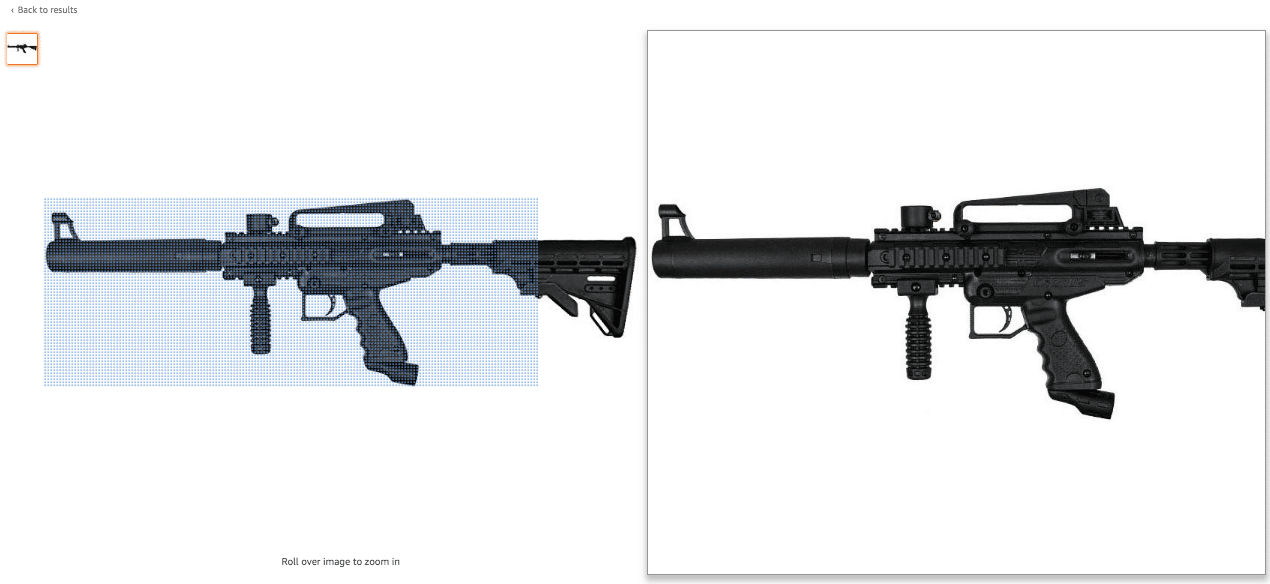
Image Source: Amazon
This offers a unique experience for the customers and can skyrocket Amazon sales for this particular product.
If you want to learn more about Amazon product photography, make sure to read the following guide:
→ The Be-All End-All Guide to Amazon Product Photography ←
This means that the number of images here is not as important as quality.
Not to say that multiple images won’t convert better than one image, just that the benefits quickly taper off after the first.
It also means that the quality of the images can have a positive impact on conversions.
You can rank better if you have one large, high-quality image than having multiple normal-sized images.
Make sure to try the DIY route to high quality product photography.
5. Price
Remember earlier, when we talked about how the Amazon ranking algorithm uses both predicted and real conversion rates to determine which products to show in their search results?
One of the biggest ranking factors Amazon uses to determine the predicted conversion rate is pricing—they know that customers tend to seek the best deals.
More importantly, Amazon uses pricing as a major factor in picking which product to show in the buy box, which is the part of the page containing the “Add to Cart” button (we’ll talk more about that later).
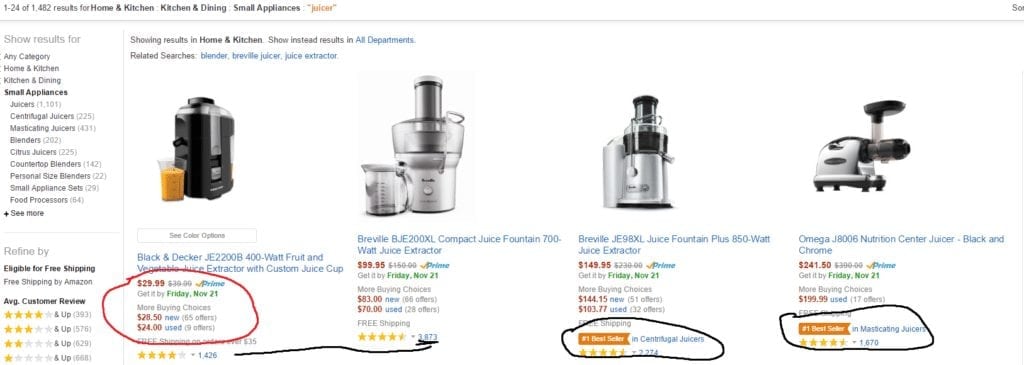
Notice here that the top-ranking product for the search term “juicer” has fewer customer reviews, lower customer rating, and lower Sales Rank than every other listing in the top 4 ranking products.
It still shows #1 because it’s got decent ratings and is priced way below the category average.
Note that product reviews are still vital here.
And pricing isn’t the only reason that the Black & Decker Juicer ranks #1.
6. Parent-Child Products
If you have a product listing (parent) and decide to offer color or size variation those are known as (child listings).
They appear on the same listing as variations.
It’s much better to use Amazon’s built-in parent-child product functionality to direct all customers to a single product page.
This has several benefits:
- It maximizes your product reviews since Amazon will combine your similar products into a single primary product page
- It makes the most sense from a UX standpoint; keeping customers on the same page makes it more likely they’ll buy your product
- Amazon has shown a preference for ranking products with multiple options in their listing
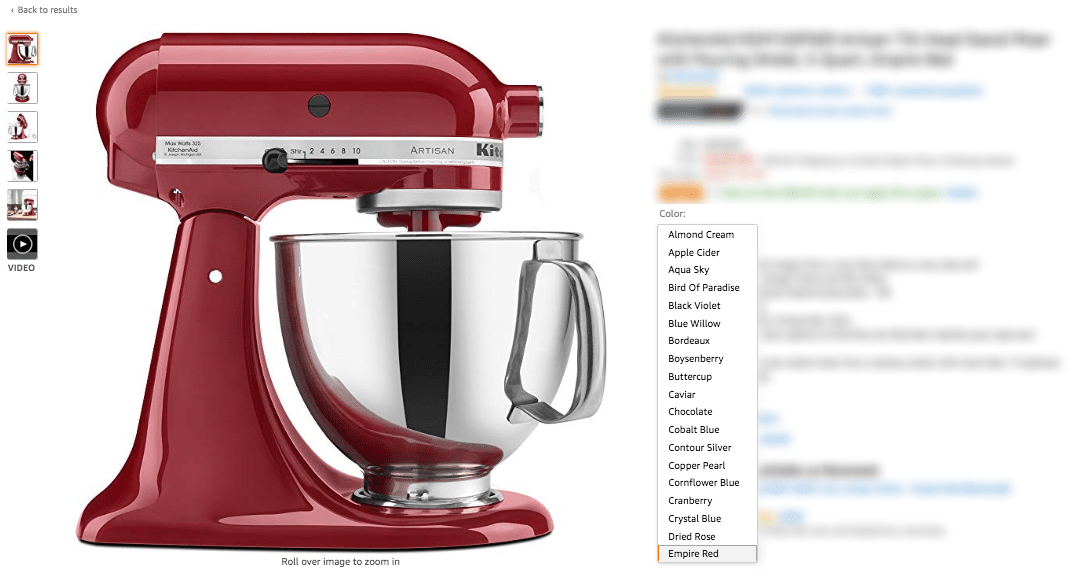
Image Source: Amazon
If you click on the “Color” button, you’ll notice that this product comes in many different colors.
Not every color is a best selling product (best seller in a specific category), but most of them are.
Generally speaking, products with parent-child product connections tend to rank higher on Amazon’s search results.
7. Time on Page & Bounce Rate
As you already know, Amazon is able to measure every way a customer interacts with their website, so it’s easy for them to track detailed time on page and bounce rate stats.
Having said that, time on page and bounce rate are indicators of whether or not someone is going to buy a specific product.
If the visitor comes and bounces right away, it means that either she didn’t find what she wanted, or that she found what she wanted but decided to proceed with the payment another time.
On the other hand, the more a visitor stays on your website, the higher the chance that she is interested in buying a product.
But let’s get to the metrics and what each of them actually means.
Time on Page: Amazon believes that the amount of time a customer spends on your listing page is a good measure of how interested they are in your product.
A customer who reads your full product description, looks through reviews, and investigates the Q&A’s is much more likely to buy than the one that spends a couple seconds skimming the features.
Bounce Rate: A “bounce” is when a customer performs a search, visits your page, and then either goes back to the search results or clicks on a Related Product offer.
Keep in mind that Amazon has a much more exact measurement of bounce rate than Google, again, because all user activity happens within their platform.
8. Product Listing Completeness
Finally, the last conversion metric to optimize for is listing completeness.
This is what most people call “product listing optimization.”
The individual sections of the Amazon listing mostly have to do with relevancy, as you’ll learn below, but the actual completeness of the listing has an effect on conversion rate.
To make sure that your product listing is well-optimized, visit the product pages of big brand and see how they’ve optimized all the different sections.
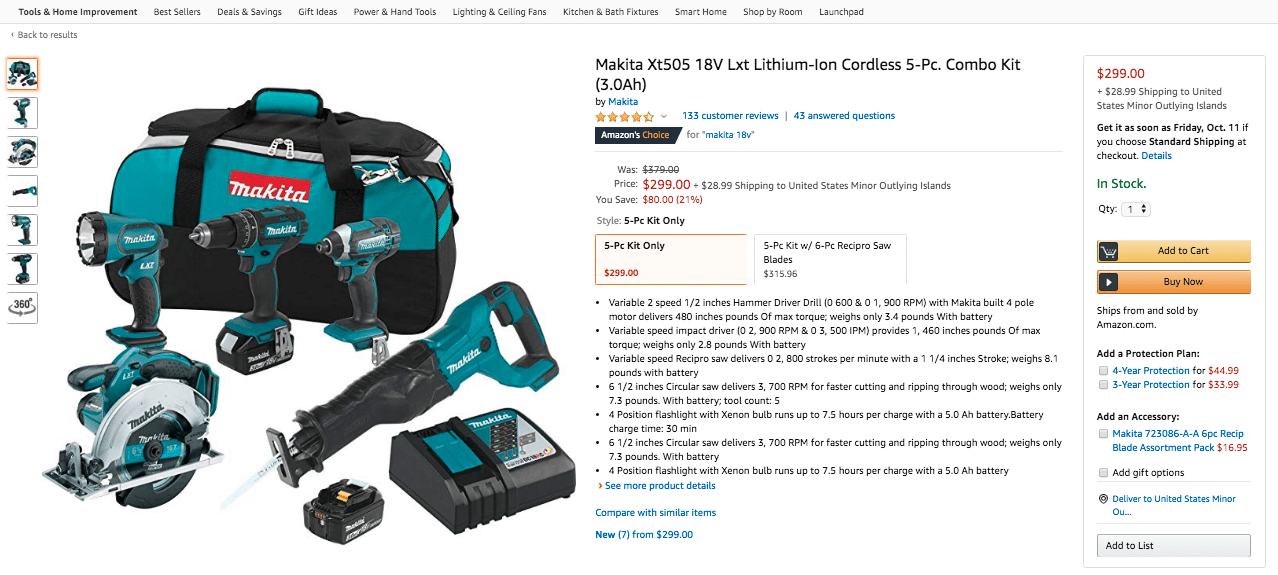
Image Source: Amazon
The more complete your Amazon product listing, the higher the chance that you’ll rank high on Amazon.
Below, you’ll find a GREAT guide on how to optimize your product listing so that it has a good chance of ranking high on Amazon:
→ The 6 Pillars of Amazon Product Listing Optimization ←
If you have a new product, do your best to fill in every single field in the listing setup page to maximize your chances of appearing at the top of product search results.
Now that we’ve seen all conversion ranking factors, let’s move on to the second category, the relevancy ranking factors.
Relevancy Ranking Factors
9. Title
In Google, you want a concise, engaging title with your keyword close to the beginning.
on Amazon, all you care about is keywords and keyword rankings. You want to cram as many keywords into about 80 characters as you possibly can.
In fact, you can actually go beyond 80 characters if you want, and it’s better to have too many keywords than too few.
I’ve seen top-listed products with titles that make no sense to have over 200 characters.
Let’s take this charger as an example:
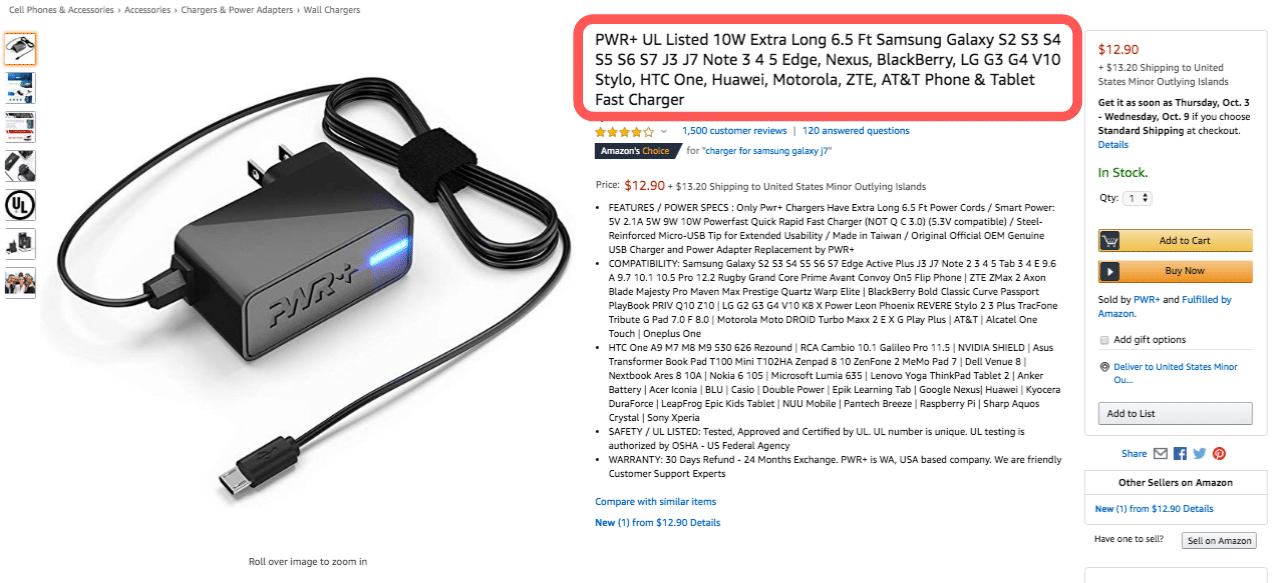
Image Source: Amazon
As you can see, the title includes brand names (i.e. Huawei, Motorola) and even devices (i.e. phone, tablet) that the charger is applicable for.
This probably helps the product listing to be more visible; however, Amazon is starting to crack down and standardize Product Titles.
So you should keep an eye out for this moving forward.
10. Features / Bullet Points
The other big reason that particular Nexus charger ranks so highly is because it has lots of keyword-rich, informative features.
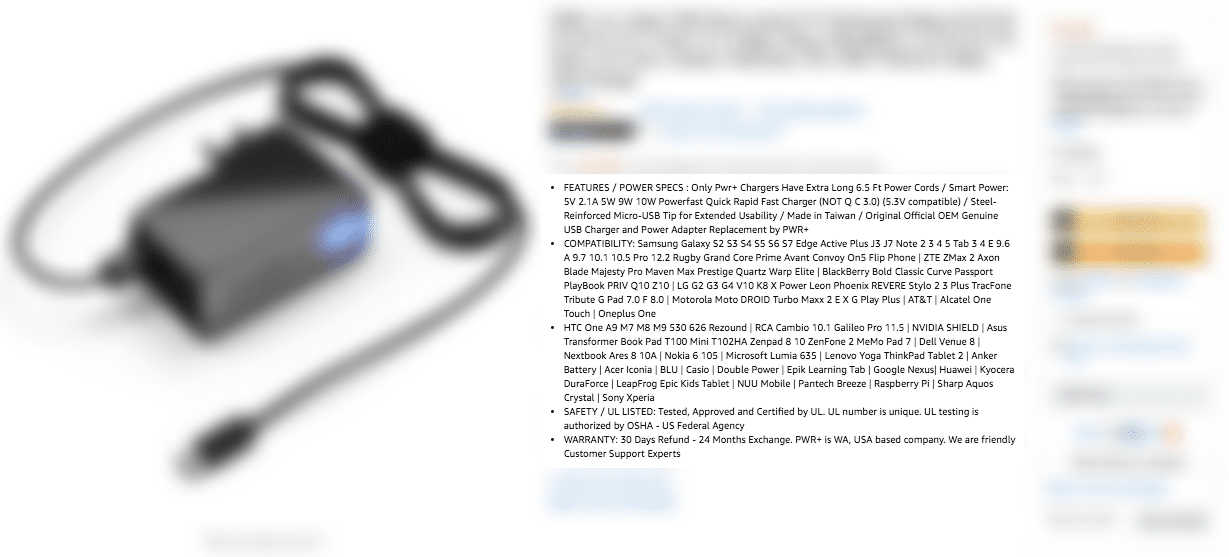
Image Source: Amazon
Features, which are displayed as bullet points right below the pricing and product options, are an absolute must.
Just like with images, features are so important that Amazon no longer allows products without bullet points to be featured in the buy box, and not having them is a serious road-block to good Amazon rankings.
Another good example of proper Feature usage is this Asus computer monitor, which ranks really high for the term “computer screen”:
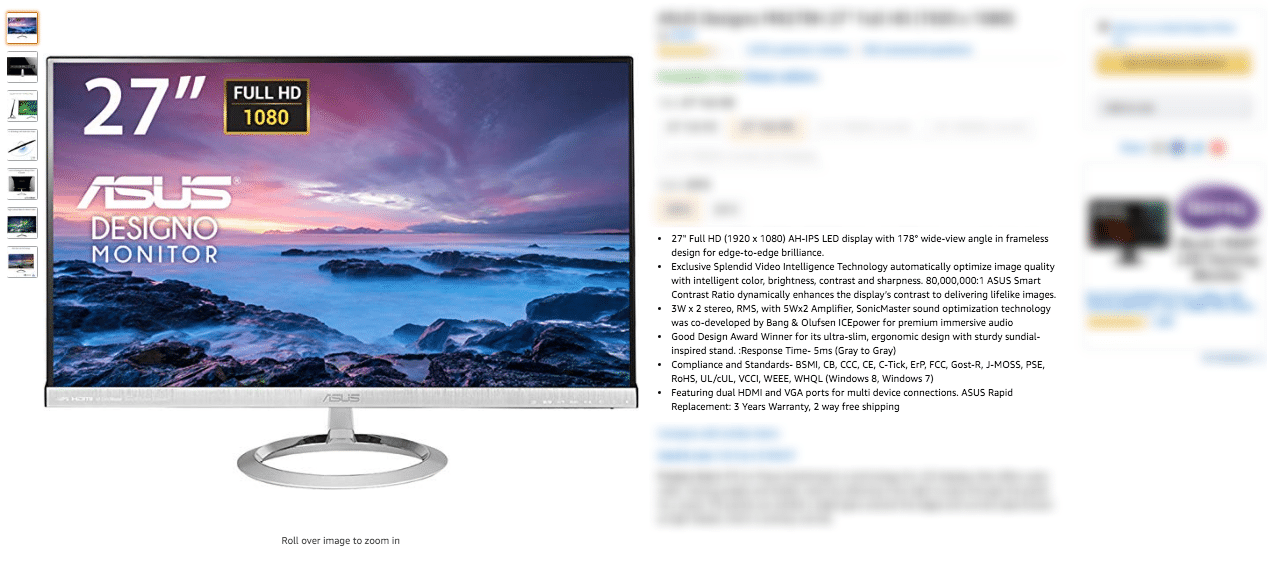
Image Source: Amazon
Notice how the bullet-points are both incredibly detailed and include a ton of keywords?
At the same time, they’re easily readable, which means they won’t confuse customers and risk hurting conversions.
11. Product Description
You don’t need me to tell you that product descriptions are important for rankings.
Your product description is basically where you expand on your Features.
It’s also the part of the page you have the most control over.
If there’s anywhere to really put a lot of effort into engagement, it’s in the product description.
→ Learn How to Write Effective Product Descriptions That Sell! ←
That being said, keep in mind that unlike with Google there is no benefit to having a keyword appear multiple times on the product page; if it’s anywhere in your product listing at least once, you will be relevant to rank for it.
If you want to see a truly appetizing product description, check out the one for this DeLhongi Espresso Maker—one of the top-ranking listings for the term “espresso maker.”
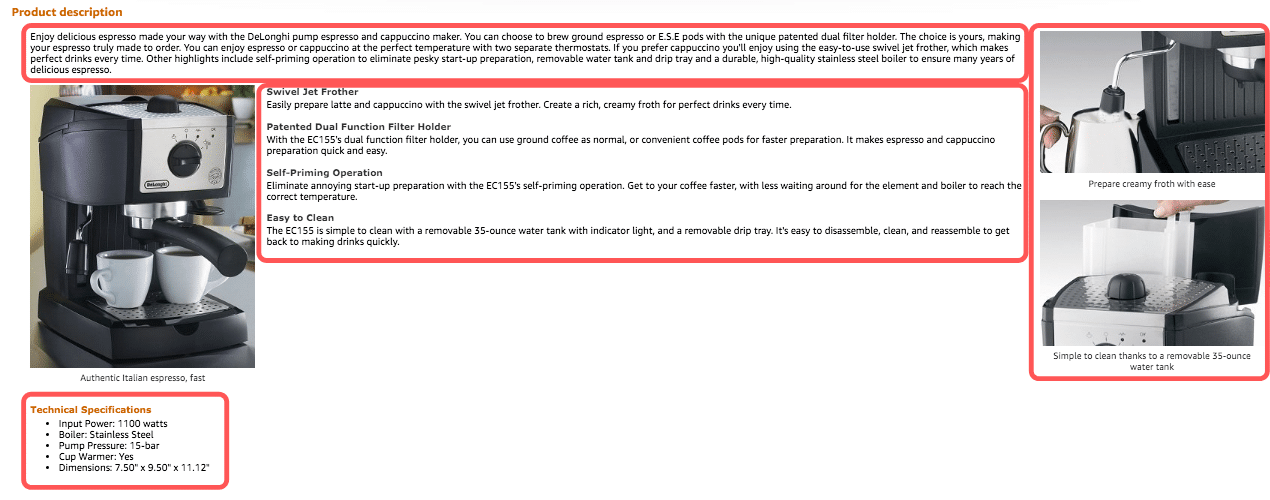
Image Source: Amazon
This listing is thorough, inviting, easy to skim, includes plenty of images, captions, and they even included extra technical specifications that aren’t listed in the normal Specifications section (which we’ll talk more about below).
12. Brand & Manufacturer Part #
Another very important thing that you need to include in your title is the brand name and the manufacturer number.
Something that every single one of the top listings does right in that category lists the brand and manufacturer number first in the product title.

Image Source: Amazon
It seems that Amazon now rarely shows a product in the top results without the brand name and—in many cases—the manufacturer number included in the title.
You always need to include a brand in your title because it enables your product for search filters AND allows you to capture customers searching for a specific brand.
Especially if you’re in a niche where customers are using the manufacturer number to search for products, you definitely want to include that keyword in your title.
Let’s move on to the next one.
13. Specifications (Product information)
Specifications (now referred to as Product information) are different than Features—this is the part of the page where you actually list the technical and physical details of your product.
This includes size, shipping weight, color, publication date (if you’re doing books), technical specifications, and more.
You can see the following #2 best seller for the “home theater” subcategory, using their product specifications to the max:
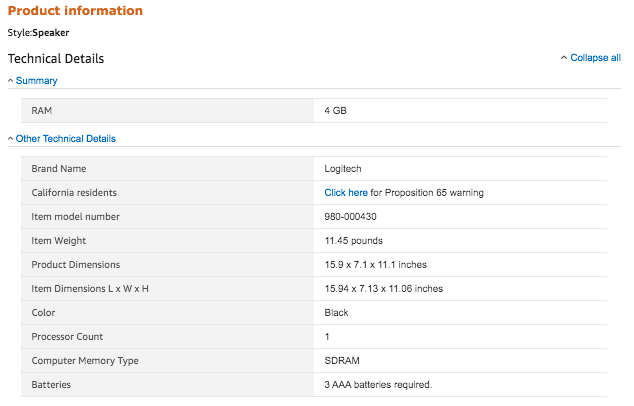
Image Source: Amazon
Let’s move on to the next ranking factor.
14. Category & Subcategory
You probably didn’t realize this, but once a customer has entered into a category—every other search they perform on Amazon will, by default, be limited to that category.
For example, when I am in the Kindle Store category, all the search terms that I am going to insert are going to be limited in that category or subcategory.
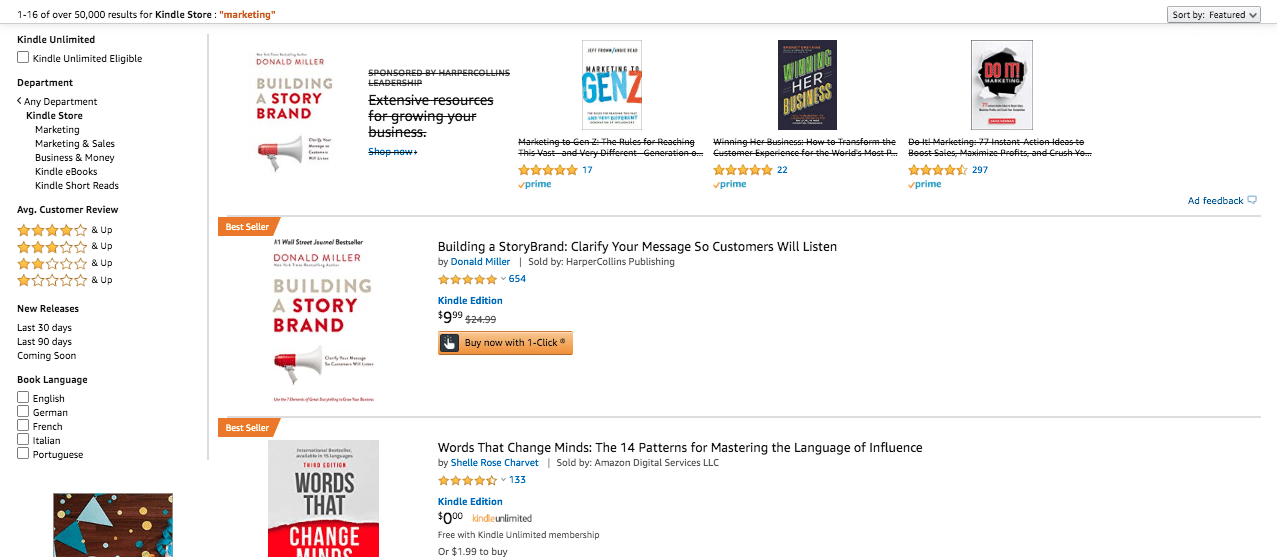
Image Source: Amazon
You can see the category or subcategory you are in at any given time by taking a look at what we call breadcrumbs.
When setting up your product listing, make sure you put your product in the most relevant, narrow category possible.
15. Search Terms
In addition to categories, you can also specify search terms that you want to be associated with your product.
Even though Amazon lists five different 50-character search term fields, you’re better off thinking about it as one big 250 character text box in which you can enter every possible search term you can think of for your product.
If you want to learn more about the importance of search terms on Amazon rankings, make sure to check the following guide in our blog:
→ Rank Higher with This Amazon SEO Growth Strategy ←
Let’s take a look at the next one.
16. Source Keyword
This is one of the biggest ways that Amazon determines a listing’s relevance to a given product search.
This is also yet another example of how Amazon tracks every single minutiae of a customer’s activity on its website.
Take a look at this URL that links to a listing for a Black & Decker electric drill, and see if you can tell me what search term I used to find it:
You can see the source keyword right at the end of the URL—&keywords=electric+drill—that tells Amazon that the source keyword was “electric drill.”
Therefore, if I were to buy this drill, Amazon would know that this listing is highly relevant for the term “electric drill.”
The next time a customer searches for that term, this listing would be more likely to rank higher at the top.
Here’s a neat little Amazon ranking hack (we cover in this article) you can do to take advantage of this factor:
- Construct a URL for your product listing using the [&keyword=your+keyword] query (append the code inside the brackets to your product URL).
- Use a link shortening service like bit.ly to create a shareable link to that URL.
- Drive traffic to the shortened link.
Now anytime you make a sale from one of these shortened keyword links, you’re basically tricking Amazon into thinking that these visitors performed a product search for your target keyword.
If you want an in-depth look at the perfect way to make your listing perfectly relevant, check out the post below!
AMAZON KEYWORDS: 4 TIPS FOR PERFECTLY OPTIMIZED PRODUCT LISTINGS
Customer Satisfaction Ranking Factors
17. Negative Seller Feedback
Why do I list negative seller feedback specifically, as opposed to just seller feedback in general?
Interestingly, Amazon actually claims not to track positive seller feedback; at least, not for the sake of their product ranking algorithm.
Instead, they track negative seller feedback rates or frequency.
It doesn’t matter how bad the feedback is—all negative feedback is the same, and it all counts against you equally in terms of search result rankings.
To be clear— as a third-party seller attempting to win the buy box (shown below) you want your seller feedback as high as possible.
However, negative feedback rate is the only metric with a known effect on product search results.
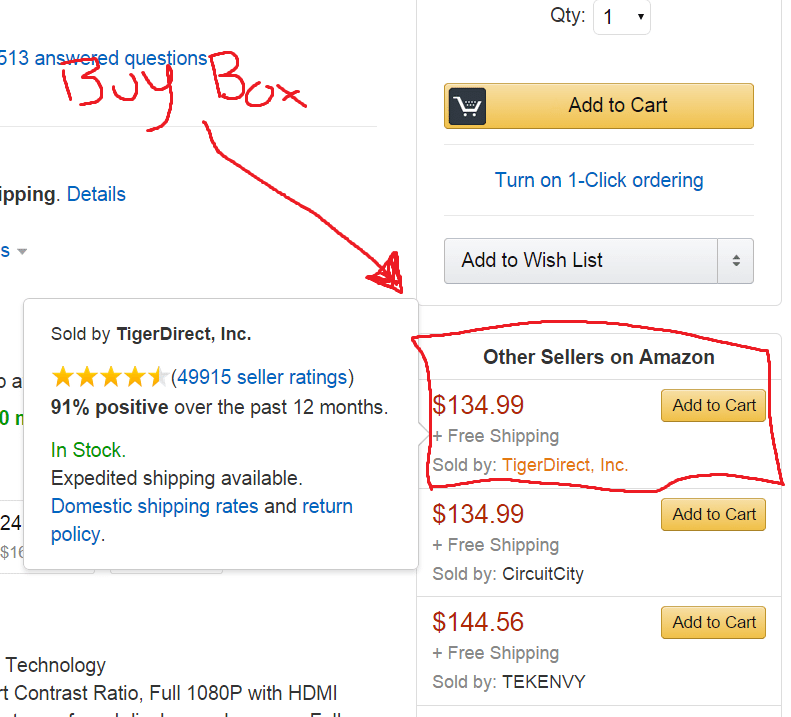
→ 3 Strategies to Report an Amazon Seller “Hijacker” ←
18. Order Processing Speed
Amazon knows that one of the best ways to make customers happy is with fast and accurate shipping.
Therefore, a vendor or Amazon seller who has shown consistent and efficient order processing is more likely to rank higher than a vendor who’s had complaints of inaccurate or slow shipping.
19. In-Stock Rate
Customers hate it when they want a product but can’t have it.
One of the most common ways this problem occurs is when an item is out of stock, or when a seller doesn’t keep proper track of their inventory.
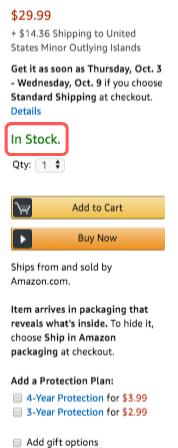
Image Source: Amazon
Whether you’re a first-party vendor or a third-party seller, keeping your inventory in stock is vital to maintaining top rankings, both in A9’s product search results and in your product’s buy box.
Two of the big customer satisfaction metrics are Percentage of Orders Refunded and Pre-Fulfillment Cancellation.
In both cases, Amazon has found that vendors/sellers with low in-stock rates tend to have higher refunds and cancellations, which, of course, is bad for customer retention.
20. Perfect Order Percentage (POP)
POP is a measurement of how many orders go perfectly smoothly from the time that a customer clicks “Add to Cart” to the product arriving at their home.
If you have a high Perfect Order Percentage, that means you have a high in-stock rate, accurate product listings, and prompt shipping.
That’s precisely what Amazon wants for every one of their customers, so they’ll naturally rank high-POP sellers above lower-POP ones.
Nowadays, Amazon also takes into account how many orders (for clothing) fit was as expected.
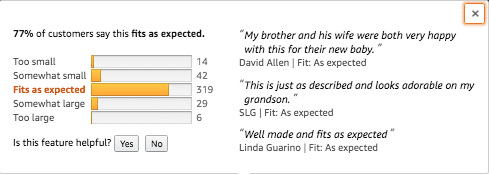
Image Source: Amazon
Even though this is a direct ranking factor, it can indirectly affect conversions and thus rankings.
Also, this metric may indicate problems with the product in terms of how it fits, which means that it obviously affects the overall experience.
We can’t say for sure that this affects how a product ranks on Amazon, but it can affect the decision of visitors of that particular product page.
21. Order Defect Rate (ODR)
ODR is basically the opposite metric of POP.
Every time a customer makes a claim with an order, that’s considered an order defect.
Here are some of the most ways an order can defect:
- Negative buyer feedback
- A-to-Z Guarantee claim
- Any kind of shipment problem
- Credit card chargeback
Each of those examples by itself would count towards your Order Defect Rate, which is the number of order defects compared to the total number of orders fulfilled over a given period of time.
Amazon says that all sellers should aim for an ODR under 1%.
Important! Buyer-removed negative feedback does not count towards your ODR.
So, it really pays to address every one of your customers’ issues.
22. Exit Rate
How often does a customer view your listing and then exit Amazon.com? That’s your exit rate.
If your page has an above-average exit rate, Amazon takes that as a sign that you have a low-quality product listing.
Usually, a high exit rate is because your product has a low in-stock rate, or because your listing isn’t fully complete.
23. Packaging Options
This is a metric that I didn’t use to think Amazon used for ranking purposes, but recently I’ve been seeing stuff like this in product search results:
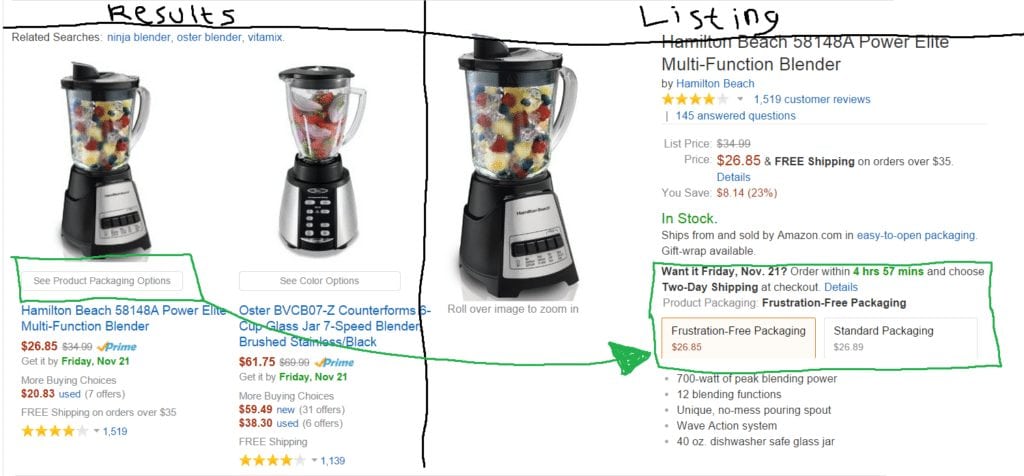
Clearly, packaging options are something that Amazon has found their potential customers care about.
But, even if it weren’t, it’s a great way to separate your listing from other similar products (and rank higher through an increased conversion rate).
An easy way to do this—seen in the example above—is to use Fulfillment by Amazon to offer Frustration-Free Packaging.
This is where Amazon uses less packaging and fully recyclable materials without sacrificing product protection. You can read more about it here.
→ Check out The 20 Top Selling Amazon Products for Your Next Idea ←
This post is getting dangerously close to 6,000 words, so I know that a lot of you probably won’t read it all.
For those of you who did, make sure to read the last chapter with some final thoughts I have regarding the Amazon best sellers rank and the other rankings that I listed here.
Chapter 3: Final Thoughts
Running an Amazon business is not easy.
Ranking a product on Amazon is only a small part of the things that you need to do to succeed on Amazon.
It takes time and requires willingness and hard work to grow an Amazon business.
Also, there are definitely some things you can’t control or can’t do anything about.
What I suggest is that you always try to improve the experience for your customers.
Besides that, I have key takeaways that I’d like to leave you with:
- Maximum RPC (Revenue Per Customer) is Amazon’s top goal.
- The Amazon Ranking algorithm uses conversion rate, relevance, and customer satisfaction to rank products.
- Fill out as much of your product listing page as possible, using as many keywords as possible. (You need to do good keyword research for that!)
- Use FBA (Fulfillment by Amazon) to automate customer satisfaction.
- Find ways to encourage customer reviews, and do everything you can to keep your customers happy.
- Above all: More sales = higher rankings = more sales
There you have it! You now know exactly what it takes to rank on Amazon.
All that’s left is for you to go out there and capitalize on your superior knowledge!
Whether you’re starting on Amazon with private label or creating your own products in China, you can rank your products with this guide!
Other Amazon sellers are starting 2019 selling via retail arbitrage. So whatever your choice just take action.
In the meantime, do you have any additional questions about ranking products on Amazon? Do you need me to clarify something I didn’t explain well enough?
Let me know with a comment below! (I’ll try to respond as quickly as possible.)
Additional Resources you might be interested in:
- Easily Purchase UPC Codes for Amazon
- 3 Amazon Research Tactics Working in 2019
- Quick Guide to Figure Out What to Sell on Amazon
Special Offer…
There’s a huge section on launching and ranking new Amazon products in our brand new Amazon business course that teaches first time entrepreneurs how to launch their very own physical product Amazon business. If you want to check that out and see if it’s right for you click here…

Thanks for sharing. I have a thought about the 16th chapter. It’s actually dangerous to use the same URL of a search result. Even if you search the same keywords, the URL will change everytime. So if you use that URL, you are not tricking Amazon, you are tricking yourself.
I actually took my time to read and take note from this article, and also click on the link. This is very helpful and I will definitely use these strategies. Thanks
Thanks for checking out the article 🙂 If you have any questions at all let me know!
Hey Will ,
Thanks for posting such a detailed blog for keyword ranking, I am a big fan of yours. I really want to join you close group/ training program but could not able to join as it is pretty expensive and I am bit tight on my budget. Anyhow, I really admire your effort to educate new Amazon sellers.
Thanks you very much for this valuable information.
Regards
Qamar Khan
Thanks for checking out the article Qamar. I hope if you have any questions at all, you reach out and let us know 🙂
Very useful information. Trying to get our products noticed online is a huge hurdle, but also very exciting. Going to follow your steps.
Hey Wendy, thanks for checking out the article! If you have any questions or run into any roadblocks at all let us know!
Nice post
Great article! thanks for the insight, helped a lot!
Hey Chris, so glad you liked it!
I Need a experienced product promoter ?
Kindly Share your number
When ranking products on Amazon, remember:
Amazon is interested in making the most money from sellers as possible.
In order to be successful selling on Amazon, you need to know how their search algorithm works. The A9 algorithm is looking to meet 3 criteria to rank products on Amazon: visibility, relevancy and conversions. The A9 algorithm lists the results from their library and pulls out the most relevant results. Relevancy matters to A9 because it decides whether it should display your product when a search query is entered. Your product name and description is the key to relevancy.
Make sure your product is categorised as precisely as possible. This will lead to it showing up in more subcategories. And out of the three factors that A9 is looking for, this meets the visibility criteria.
Product image is also one factor that should be considered, who would buy a product that looked rubbish? I know I wouldn’t! I share the same opinion as the millions of potential customers out there. The pictures must clearly show the product in full. I would recommend that you use a picture that is 1000×1000 pixels in size. This is because it allows a user to zoom in by hovering their mouse over it.
These are only few of the many techniques that can be done to make sure the product posted will rank highly in Amazon.
fascinating information. literally i have read from top to bottom and now hope i’ll be ranking at the top. thanks
Fantastic information, just read all of it, so hopefully I will be successful
Great info. Thank you!
Everyone who runs an online business with Amazon wants to ensure that they are getting high ranking since this will help increase the conversion much better. This article is such an excellent help to individuals who are having challenges with their ranking
wow, superb..
really intrested article. thankyou for this article.
I’m Alwayes follow your blog.
Really helpful.. Thanks for sharing such precious knowledge.
A very very help full for newer an amazon affiliate.truly it’s amazing
Hi,
I like the advice you have given in this blog post.
Can you please show us how to do this part of it.
Construct a URL for your product listing using the [&keyword=your+keyword] query (append the code inside the brackets to your product URL).
Use a link shortening service like bit.ly to create a shareable link to that URL.
Really this blog helpful for rank a product on Amazon. and I follow this steps and let’s see what happen. Thanks for sharing.
When I am doing any changes in product pages from inventory panel, our product seller rank is increasing despite of decreasing frequently. Can someone tell me, why it’s happening? And how to overcome it?
You can see our products page on amazon by searching “RD Mounts”.
When was this published? Things change so fast on Amazon and I hate reading content that’s 1+ years old. It’s impossible to know if an article like this is worth reading when I can’t find the published date.
Hi:
The very much required information which you wrote over here, are those applicable on amazon.in also?
Regards
Partha
Hey Will Mitchell,
Thanks for writing a great article. I love it and also implement in our all products and I am sure your tips will definitely work.
I have also one more question. If you have time please give me a reply.
My question is, Can I get potential buyers on our Amazon products if I promote our products on social product submission sites like wanelo.com, theproductrank.com, and etc…?
I hope you will give me best answers.
Thanks again.
Clara
Your content is really helpful! But, I’m still a little lost on sourcing keyword. How am I supposed to construct a URL? Another question is how can I determine which keyword to target for my product? How do I know if the keyword I’m targeting for has sufficient search volume?
May be we all know these stuff but reading all together is a refreshment for mind to act and perform better selling on Amazon.
These are very simple steps we can easily follow but we do mistakes by not taking them seriously as we go older with selling concentrating only on increasing the sales but we forget that these are the basic Tools we must have always 🙂
Thanks Will Mitchell for collecting all the stuff together with awesome presentation.
this is really a helpful post for all those who already have store on Amazon or who are looking to create like me. I need to now that which product we should sell? can we sell the product to other countries too ?how will we send these products to other countries? and most important how to research which product is best to sell on Amazon? please answer it would be more helpfull from your side.
thank u 🙂
great !i want to start my e.commerce store i need few suggestions on can you tell me ,how to contact you
How can you find a company or person who is an “expert” with creating your Amazon page? I need help with my product….
Hey, I use Panda Boom they are top performers in every aspect of the business listwrting external traffic and blogger services that boost my reviews and ranking. super recommended
Thank you for this post has helped me in what I was looking for. I have one question my listing is not discoverable on when I search specific keywords which means I wont be getting any sales = no reviews. what is the best way to rank my listing.
Thanks.
Hey cool except think the # of kws needs an update right? it’s strictly limited to 250 isn’t it?
Wow… (we say waawu where I come from). this is unarguably the best post ive read concerning search engine optimization. i took a 4-page note. thank you for this write up. im currently doing my product research to determine what to sell on amazon.
This is a great post! I am new to the Amazon selling world and this helped tremendously! I am part of a team that is starting from scratch to use Amazon to ship our product FBA style. Most of the team would prefer to ship FBA and not FBM, but the expert of the team says that having more ASINs help our ranking and sales. I am not sure if that is true because right now we only have 5 products for sale, with two being a variation of each other. Do ASINs really help your sales rank?
Hi Will,
This is a great share.
I am very new on Amazon platform. Your guide really help me so much.
Hello David,
How is your journey on amazon so far ?
Geez, it almost seems like “Amazon SEO” is even more complex than regular SEO! Amazing guide though, especially for someone like me who’s just getting into selling on Amazon.
In a way it’s more complicated because you can’t directly control the metric “conversion”. All you can control is your product quality, Amazon ads, your KW research & the SEO copy.
So as sellers, we just focus on the tasks that we have complete control over.
This is one of the best posts in terms of style and voice I’ve read on such a tedious and uninteresting topic. Thanks for not making this sound like it was written by the voiceless, homogeneous blog monster that seems to write every marketing blog post. (I think the Patel guy may have ruined the whole internet.)
Bonus points for not using the line tool in ms paint.
Also very informative. Thanks!
After reading this post, I have more and more reasons to build a stand alone e-commerce business, rather living off Amazon. Especially the “lowest price” point, I don’t think Amazon is a good place to sell high-end products, or even average ones.
Just push a lot of cheaply-made products with ridiculously low price, then you shoot to the top on Amazon. That’s okay, good for THEIR business, not mine.
Anyway, thank you for your post. Very good & useful one here.
All above is probably useful for people who are not aware of online business rules. The intention of Amazon search engine is to make the buyer happy to grow Amazon business ( not yours in particular, as there are many other sellers happy to replace you ) So whatever Amazon does , it does it to increase their profit by getting the most possible conversion and improving buyer experience. This means that the above information about , product description, bullet points, keywords, feedback etc etc, are pretty obvious. What is not pretty obvious is that Amazon software is not written very well. I am not not only a Amazon seller, but also software programmer. I was really surprised discovering how many bugs Amazon developers managed to produce in their API and its documentation. (also reported by many other software developers ) example : it allows developer to do much more, than Amazon predicted and more than you can just do in seller central! Example: By API , you can update the despatch time of the order to whatever reasonable value even if it has been already marked as despatched , in seller central you cannot!.
Another funny example. Recently Amazon scanned listings in automotive categories to stop people using car makes and model in Product Name ( forbidden according to t&c ) but guess what, People selling printer paper in format A4 and A3 received warnings that their products will be banned within few days ( because for Amazon, the A3 and A4 paper formats in Office supplier category is the same as A3, A4 Audi models ) and car makers still use forbidden car makes and models in their product titles, because Amazon is not able to find them. Yet another example, Amazon does not allow to duplicate the listings. No problem for clever sellers, who buy EAN numbers and list as many duplicated items as they like, increasing probability of sale. So, if you are new to Amazon and you really try hard and follow all the rules, you still have low chance to win with sellers who do not follow these rules. Another example? Amazon does not allow you to use any logos, watermarks and frames on the photos, so why is it possible that there are lots of sellers sill using such photos for years!
Hi, I am very new to this. My goal is to sell branded products on Amazon. But I cannot be having a huge inventory for that. Max I can have is 10 pieces of a good branded product since I would like people to get the quality stuff. Do you think it will work ?
Wow! A great post over Amazon SEO. You have just nailed it. I would like to write something like this. I wish I could.
Great post. Very useful information. Thanks.
Wow, what an amazing post. Especially enjoyed the deep dive into the A9 algorithm.
Thanks so much, i never thought there is so much to check on before selling on amazon. Though i yet to start, will do more efficiently now. Thanks again.
Thanks for the post, very informative! I have a couple of questions on ranking.. People at Jungle Scout advise to promote your product with discounts through Jump Start to gain more sales, otherwise they say the product could get stuck on page 20…do you agree? I am based in the UK but Jump Start does not support this country (yet). What can I do to boost my sales and rank higher?
About fake negative reviews from your competitors…it happens, and they can sink your rank. Amazon seems quite responsive to remove negative sellers reviews but not customers reviews. What would you suggest to do?
Thank you for your help 🙂
This post is very helpful for me to Improving Alexa Rank of my Blog
Thank you so much
Hi
Now easy to understand how amazon product rank.
it’s help us to rank more effectively our customer product. We can see the result with 2 week
all thank’s to you & Well researched post.
Regard
Tarun
Hi Will,
I have a few questions on SKUs as it relates to private labeled products, I hope you could address each individually (thanks in advance!):
1) Does the A9 index the parent SKUs or the children (variation) SKUs? 2) If I change the parent SKU, will that affect my A9 search ranking?
3) Can the Parent SKU be made static or does Amazon keeps changing as the variations are added to the parent?
4) How do I find out what is the parent SKU for my listings?
I have more questions but the above three are fundamental to the discussion.
Thanks again for your input!
Awesome post to share. Thanks a lot for this share. I loved reading your tips on SEO on
Amazon. Keep blogging. Cheers..
Great article!!!
Passed over 4000 words :))))
The No of words should not be a problem comparing to the benefits brought by this article(or similar ones)
Thank you for sharing!
Really Great!
you really good
Good tips for amazon seo.
Great tips for me thanks
Great article thanks for this.
http://www.SeoExperts24.Com is the name fo Amazon seo expert team. If you
need any kind of Amazon work such as product listing, Product optimization, product
ranking, product review, increase sell etc then contact us.
You should keep your product top positions on Amazon search
result to get huge sales. That is why we are here can help you to rank your
product on Amazon Top positions like Top #1, Top #5, Top #10, Top page or
wherever you want.
Check How We Work:- http://www.SeoExperts24.Com
Yes. thanks for Shearing it i know about this strategy but little bit Confused. When I read this My confutation has gone. But I think Amazon Algorithm updates Regularly. Day by Day its so hard.
Great help….. thanku so much
want your help anytime please leave your email id so i contact with by emails
such a great article i have ever read to boost my sales
now i will impliment these ideas and see my results
Does anyone know if Amazon factors in the add to cart rate for your product. I would think that the more people add your product to a cart versus other product, the more that demonstrates to Amazon Relevance.
Answering every single comment my ass.
I want to give you a good advice, please add me on your skaype. my id durerhabib
Excellent post here. Do you want to increase your amazon sales/sales boosting?
So you should rank up your product in Amazon search.
Here is an amazing offer with amazon SEO. Keyword/Product Ranking.
Get first page and top position for your products. contact me………..seobakulsarkar@gmail.com
Hi, Will Mitchell , I really like your article because this article is very informative & well descriptive. keep continue your writing.
I really like your tips on SEO on
Amazon. Not everyone immediately thinks of Amazon when they think of
SEO, and it’s important for people to learn tricks and tips on how to
improve optimization.
if you are interested,you can visit my link and share this……
Moniruzzaman Khan
I am read this article very carefully,It’s a nice host site. It’s really help for us……very nice info. Thanks a lot…
if you are interested,you can click my link and visit this…………..
Does having video reviews of your product help your Amazon search rankings and/or conversion rates?
i am amazon any product rank fast page[seo] eakub123.to3@gmail.com
Hi Will,
do you think stuff has changed recently with Amazon’s Algorithm and how easy it is to manipulate rankings ?
We ran a big give-away campaign and gave away over 250 units with a 85% discount yesterday.
The product even earned the bestseller badge in it’s category and was even #1 in it’s parent category, but it seems like nothing has changed in terms of our product rankings ?? Isn’t that weird ?
Also the BSR hasn’t changed significantly.. We had the orange “bestseller” badge, but the BSR was still at 81 or something, I don’t know maybe it hadn’t updated yet..
But overall, I am not that impressed with the results. I did another launch last year and it was far easier (and probably cheaper) to get great results.. Do you have any advice ?
Thanks!
can u tell me about those product…..
my contact..
steveMMorris145@mail.com
Hi Greaves…..your product really help for us..
Because those product very popularity for world…
thanks and i will bye those product
Has anyone actually used these guys in the comments claiming to help get a product through the rankings?
Really great post. In regards to stock inventory. If you run out of stock and suspend your product listing does it effect your seller rating?
Very nice explanation. Excellent post with detailed information. I have some products which are listed on amazon but they are not appearing in results when i search in amazon.
i ranking to amazon product within 8hr.
Recently Amazon changed their search algorithm and now top ranked products in 1st page are now going to 5,6,7 etc. What do you think about this?
many thanks
Really excellent post here. Thanks a lot. Do you have any thoughts on the 5000 characters for backend keywords? The parts I’m struggling with are how it should be structured, as in should it be readable. I have heard it should go in a logical order. Also, I am really really struggling to fill it all out. Even using various keyword generation tools I find it impossible to get to even 1000 characters without repetition. Any advice would be highly appreciated.
Thank you for much for putting together this article! I have been looking for this type of info condensed into one place instead of clicking around the amazon seller base aimlessly… and I DID read until the end of the article!! Thanks Again!
My name is Ali. How much do you charge to make my products visible and top ranking?
I want to work with you dear brother.
Hi
Great info. Easy to understand and most helpful to me as a beginner selling on Amazon.
One question. How do I construct a URL for your product listing using the
[&keyword=your+keyword] query (append the code inside the brackets
to your product URL). Can anyone give me an example.
Awesome article! Thanks a bunch! =)
I am providing amazon product ranking service, I have big team, if need please visit my profile/website.
it’s informative for amazon seller.
I also providing amazon product ranking service, I have big team, if need please visit my website.
This is a wonderful article.
I also providing amazon product ranking service, I have big team, if need please visit my profile/website.
I am providing amazon product ranking service, I have big team, if need please visit my profile/website.
This is a wonderful article. Really it’s informative for amazon seller.
I also providing amazon product ranking service, I have big team, if need please visit my profile.
it’s a wonderful article. Really it’s informative for amazon seller.
I also providing amazon product ranking service, I have big team, if need please visit my profile.
Thank u brother . I am a new worker. Few days ago i ranked a product by wish list , i dont know how to purses please help me .
Hi Will,
Fantastic article. I work for an eCommerce broker/agency and I might start using this to give our new hires a quick 101 on Amazon search algorithm. Very easy to follow and a ton of good info.
Your sources were the A9 website and seller central, correct? Any additional sources?
Thanks!
Mike
Hi Guys,
I have a product that has a parent item and Children. Should I be entering search terms/keywords for each child item or does Amazon only count the parent item? Thanks so much for all the valuable information!
Thanks so much for this useful & wonderful article,
This gave me a real boost of knowledge, but I would like more info about the SOURCE KEYWORD paragraph,
Please advise,
THANKS
Great post Will. I think with it being late 2016 this article could be updated for SEO on Start Up Bros, and for accuracy and the latest and greatest. I would be aware of the URL trick and other changes the last 12 months.
This is a wonderful article. Really it’s informative for amazon seller.
I also providing amazon product ranking service, I have big team, please visit my profile/website.
*You can contact us for Amazon Product Ranking. We can make you amazon best seller*..
Hello
How to contact you please suggest we need help on amazon ranking
My contact number whatsapp 9811336733
*You can contact us for Amazon Product Ranking. We can make you amazon best seller*.
*You can contact us for Amazon Product Ranking. We can make you amazon best seller*
hi!
I have a mandoline slicer 3 weeks on sale on amazon. Sales are on an average of 2 pieces per day. Please advice related to how much money to spend a day in advertising and what keywords to use.
Thanks so much, Dana
This is a wonderful article. Really it’s informative for amazon seller.
I also providing amazon product ranking service, I have big team, if need please visit my profile/website.
I want to rank your any competitive keywords, just add me on your skaype my id is durerhabib
You can contact us for Amazon Product Ranking
Hi, thanks for a great article!
hi! i love your articles. i am very new to amazon so here is my question. You said to fill out every part of the product description when listing a product. What if you are selling a product that already has a listing and you are simply copying the ASIN when adding a product where all the information has already been filled in.
good day dear,if you need an amazon seo expert, I will agree to work with you.thx
Thank you for this wonderful article. Really informative.
You can contact us for Product Ranking
Hello ashadkhan how to contact you
Awesome Article!
Thanks so much for sharing as I will be listing my first product soon and this is a clear cut way to weed through alot of the unknown factors that you have laid out in a very clear fashion here.
Cheers!
**You can contact us for Amazon Product Ranking. We can make you amazon best seller**
When was this written?
I loved reading this, but it only works if you personally create the listing page. If you are selling something that already has a listing you cannot amend anything on it of course, nor add bullet points etc etc. Sure you can add keywords to your product if you click on edit item, add extra photo’s, which may or may not show up, but all of this makes no difference at all.
Amazon only take into account the details in the original listing. I have tried and tried over 4 years with 20 products, so I’m not a total newbie
Hi Will
Thank you first for such a wonderful article. I’ve taken down several.notes while reading and will Implement each of these instructions into my listing
Coming to my question,
I’ve been using Amazon PPC for quite some time. Today while researching, i noticed that some ads appear much bigger in full length at the top or bottom of the page as sponsored ads as you will see in attached image while some appear relatively smaller on the right hand side of the page.
Will you have an idea of how Amazon chooses which ads should be shown full length at the top or bottom of the page?
Hi, great article! I would like to know, if I have a new product and my brand has a single product listing but has more reviews than similar products and the listing is tight…do other brands that have multiple products (same category different product) with reviews have a higher chance of showing up on top listing, even when that specific product has less reviews than mine?
Hope I didnt confuse too much.
Thank you!
it’s informative for amazon seller.
I also providing amazon product ranking service, I have big team, if need please visit my profile/website.
Wow, I want to thank you in advance for this awesome article. Do you have any articles on maximizing the use of Amazon sponsored ads?
Thank you.
Hey Will,
Lots of great info here, thanks. I’ve noticed that some products have more than one product category that they belong to. How can a seller add their product to a second or third relevant category?
This is SOOO useful. Thank you. Not sure how old or out of date this post is but it has made me relook at our Amazon listings with new eyes.
Wow, Will. I’ve been selling (books, which no one wants now, it seems) on Amazon for 13 years. I figured out keywords/search terms a few years ago. They really work, but they keywords/search are the same thing, when you test them. I just complained about this last week. Poor coding.
But the other stuff in here is gold. Fantastic.
Hi Jason,
Nice read. Is it possible to still insert photos in the description section of a product listing? I have not been able to do this, and I know amazon now dislikes even basic html code. Though I believe there is a feature where you can pay amazon a premium to allow for a nicely designed description section. What is your experience with this?
What an excellent read! Thank you for sharing this article, Will. Still got a lot to learn about Amazon. This post made me learn more.
Just couldn’t go without giving a reply! I am in this post around 30 mins and I didn’t notice once, that’s wired. I just understood while I saw, you said that it is about likely 4,000 words post!
What you did here!
I am in doubt, maybe Amazon “itself” will be in the confusion that how would you evaluate and gather such the information about the A9 algorithm of Amazon. You just simply describe the most promising points of view that how the seller can think better and can make sure what’s the exceptions that the toppers are using and going through!
You have needed to research a lot of things to collect the relevant examples and just made it a solid piece of theory to get forward one step more than the last day! But I am sure that you had some kind of real-life experience and the challenges of Amazon Sellers! You did the best performance here what I feel. However, I have copied your ideas for FREE and going to apply it one by one!
You deserve more than appreciation,
Mamun
Would love more information on how exactly to do this
Here’s a neat little Amazon ranking hack you can do to take advantage of this factor:
Where would you construct the URL in Amazon? on another website?
Construct a URL for your product listing using the [&keyword=your+keyword]
How?
query (append the code inside the brackets to your product URL).
Use a link shortening service like bit.ly to create a shareable link to that URL.
How?
Drive traffic to the shortened link.
Now anytime you make a sale from one of these shortened keyword links, you’re basically tricking Amazon into thinking that these visitors performed a product search for your target keyword.
Hi, Will:
Thank you very much for your sharing. we make the bags for the customers in USA. but it is through somebody there. i think it is the time for me to sell directly in Amazon. or we might work on it together.what do you think?
Look forward to your reply!
Philip
there are lots of great selling products match the way you describe. Your article is really great.
I have a question toward keywords in search term. How to spy these terms of those great selling products? I mean by understanding the way they doing, newbies can grow better.
Really appreciate your great article and look forward to your insight.
If this post isn’t in a newsletter or ebook, it should be. Excellent in-depth discussion.
Hey Will,
Thanks for these awesome tips! Such an in-depth explanation of how to optimize your listings…don’t see many other resources like this online. We are writing an eBook for Amazon sellers, and will definitely include your tips in it (and quote you as the resource, of course!). When the eBook publishes, I’ll be sure to send it your way.
Thanks,
Tiana
I’m just checking… I left comment yesterday but it is not visible here. Do you validate all comments before you show them online?
damian
Hi there,
I got 2 questions:
1. Do you have any hard figures PARENT-CHILD products actually sell more?
Don’t get me wrong, personally I am big fan of this kind of listing products (not only on amazon but any other channel too)…. but…
We’ve been speaking with German Amazon support (we are polish company focusing on german market) and one of managers told us they do not really advice having variation products. In this guy (there is no official statement) opinion it is better to have 20 search records (in case there are 20 child products) than only one.
I am really confused… help
2. How do you actually create such description as you shower in “Product Description” section?
As far as I know any media, tables or column layout is reserved only for Amazon itself. None of external merchants is not able to create such description for own item… or maybe I am wrong?
btw. great article 🙂
really really helpful….Thank you….hope we can be a friends..
Hi Will
Brilliant post! Do you know all this from your experience of selling or have you worked at amazon before?
I have a question. You spoke about the factors affecting conversion and relevancy but didn’t mention about the factors for customer satisfaction and retention. Are they the same or are there any different ones?
Thanks
Hi it’s a great post and I really liked it thanks again.
My question is
I have like 10 items for sale on amazon and 2 of them are #1 best seller and I’m very proud of my self by saying that 😉
The thing is when I search my item in one of the top keywords I still don’t come up on the first page I would like to k mm pw why
Thank you
Hey Will – Believe it or not, I got to TOO LONG DIDNT READ and thought .. Nooo it’s over?! Great article. I wanted to see if you have had luck/good results or used the search terms hack yourself? And if you know other resources for other ‘hacks’ that could be useful especially when starting out?
Thanks!
Hello will
Wanted to say great article learn so much and have a lot of homework to do.
Thanks the info
I have heard that SuperURLs are now no longer working (Amazon has figured it out and blocked). So, if you’re in a super competitive category and you can’t just ask people to click though the pages manually until they find your product and then buy to help you rank (because you can’t find the ranking position of your product or it’s on a super high page, for example) – what can you do to get ranked by generating sales against your main keyword?
HI Will,
Its really very important information that you have mentioned.
I would like to know how can we put more colour options on amazon(Right side above bullets)?
Is it good for the sells? I am looking that option from long time but didnot.
Thanks for your help.
Ravi
Hi!
Could, please, tell how to create different sizes and packing options for goods on Amazon (I have similar goods, but 10 sizes and 3 packing quantities of each).
Thank you!
Was thinking about starting selling on Amazon couple of days ago and stumbled upon your website. Now I am convinced that I can also become a successful Amazon seller.
I am currently still in the Products searching process, I have also ready your article about that. But here is a question:
You have mentioned that the top products always name brands and article numbers. So if I am importing from China, there will be either no brand or it will be something completely unknown. I also don’t want to sell fake brand copies.
So what is your advice for that? Just make up a brand, or what is the best option here?
I also providing amazon product ranking service, I have big team, if need please visit my profile/website.
Awesome post!. Thanks for sharing valuable information, I am amazon worker, I help people to grow there sales on amazon by optimizing there product, My work is amazon basic, But i used your valuable information with my Technic. Amazon become Sticks now, So please tell me why amazon withdrew past reviews? I am happy if you advice me. Thank You
Excellent post. Very valuable information. I am also an Amazon seller, who has a great product and am constantly looking for better ways to get the word to potential buyers. I am very appreciative of this information and advice.
This article is informative for amazon seller.
I also providing amazon product ranking service, I have big team, if need please visit my profile/website.
Wow, that´s really awesome post! It´s quite a time I have read an article of 4000 words and did it till the end!
Are there some other good resources You´d recommend for further reading?
How about the follow-up 🙂 https://startupbros.com/amazon-ranking-hacks/
OK, regarding FBA, there is a couple of drawbacks.. The major disadvantage to FBA is the cost. Amazon charges a monthly fee for each cubic foot of warehouse space used, so FBA is especially costly for long tail items that may sit around for a while before they are purchased. One way to combat this cost is to use Amazon’s Inventory Health Report; it shows you how long inventory stays on the shelves, and if you’re restocking too frequently or not often enough. FBA also charges fees for handling, picking, and packing. These are weight-based. It is wise to use the FBA Revenue Calculator to calculate how hard these fees will hit your business.
Doesn’t look like you are responding to this post anymore, but I’ll ask anyway.
My question is in regards to creating a link. Does this trick still work? Or has Amazon changed its effectiveness? If it no longer works, is there an alternative method that will help?
Thanks
Hi, I have a specific question. We have observed that the sorting by avg. customer review is not simply ranking by avg. star, because products with higher avg.star may rank behind the lower one. Do you know the exact rule they utilized?
This site was… how do I say it? Relevant!! Finally I’ve found something which helped me.
Cheers!
Hi, do you know if having amazon fulfillment affects your ranking?
Great article, especially the part about “source keywords”. At AMZShark, we call these “Super URLs”, and we made a simple tool to make and manage them, then track the ranking changes that result 🙂
New to your blog, looks like I have a lot of reading to do 🙂
Matt
With regards to what you wrote about ” Source Keywords”:
With regards to step one of constructing a URL, the URL should start with:
http://www.amazon.com/
Correct?
Such as:
http://www.amazon.com/s/ref=nb_sb_noss?url=search-alias%3Daps&field-keywords=white+iphone+case
For the keyword terms “white iphone case”
Then create a bit.ly for this and drive traffic to the bit.ly URL
Is this correct?
Thanks for a marvelous posting! I seriously enjoyed reading it,
you maay be a great author.I will remember to bookmark your blog and may come back very soon. I want to encourae yourself tto continue you great
work, have a nice day!
Great article…
I didn’t see you mention Seller Feedback… this is different than Reviews (for newbies that may be reading) How does this effect you – especially since if you do FBA then this part of the transaction is all on AZ to get it right… (except for customer questions) How does Feedback vs Reviews move the needle in a positive direction? Cheers,
Jake
Hi Will
This article is great. I am currently looking for any buy Box Tracker? I have searched quite a bit but I am unable to find anyone. A little help would be appreciated 🙂
Will, my question relates to the marketing of eBooks (Kindle Direct Publishing), Print on Demand Books (Amazon’s CreateSpace and possibly Audio Books (Amazon’s ACX). I’ll pass on your comments to my group of 400 Authors on FB.
We have concentrated to date on:
1. Category and sub-Category selection
2. A well written product/book description
3. Professional and properly designed book cover image
4. REVIEWS, REVIEWS AND REVIEWS!
Our group, with the algorithms in mind has a basic process, where members schedule and event, noting the free availability of an eBook through the Kindle Select program. That eVent is posted to the group, where members can download (R&R) read and review their fellow member’s books. We understand that somewhere in the metric, there is a magic number of 100 reviews.
We also ask members and friends to post the review to Amazon’s Goodreads site. We are quoting a VP at Goodreads, who noted that the Goodreads search engine will not recognize a book with less than 100 reviews.
In addition, we have heard that asking friends (our 400 members) to “vote” on each review on Amazon, as being “HELPFUL” may serve to pin those reviews to the top of the list and may have a similar effect of pushing “NOT HELPFUL” (ie: crummmy) reviews to the bottom or even off the list.
Finally, a question: Do you know if we are targeting actual variables in the Algorithm, with our Download>Read>Review & Vote process?
While we hope that our efforts are not in vain, are there any other variables that we as Authors can impact?
We have posted your blog to the attention of our group (the Authors Pay It Forward Project) https://www.facebook.com/groups/authorspayitforward/ and look forward to any flashes of brilliance you may share. Muchas Gracias!
David
Automated Review Request.
I have read often in the seller forums that prompting a customer for feedback (a review) is not a good idea and that amazon’s algo’s punish those sellers. However, then I recently saw that amazon put out a series of videos to ‘help’ sellers. One of them recommended that sellers contact customers after each sale using this feature. Have you written about this elsewhere ?
Hi Will,
First I have heard of you and thanks for the awesome article. Do you have any articles on properly seeing up and maximizing the use of Amazon sponsored ads? Thanks.
I was actually browsing this page to inform people about where to get UPC and EAN codes but you have written such a great article about selling on Amazon and all the factors about ranking and selling more, even me -and i am selling since decades on Amazon- learned a bunch of new things. Definitely one of the greatest reads for Amazon sellers i have ever came across.
I see some sellers that have BSR ratings in several categories. When they loose the #1 in one category they get it in another. I have had Amazon add search Node ID’s to change my category but still cant figure out how to keep more than one BSR on my listing.
Will,
Can you guide me to a tool that will allow me to upload a list of UPC codes and prices that will scrub the data and compare it to the API in Amazon and provide me the seller rank and number of sellers and estimated FBA fees and profit per item?
Will,
Good info. Have been selling on Amazon for some time now and we now do a lot of
fulfillment. Seems worth it to ship the products to Amazon and be done with it.
We sell in the beauty catagory and have been very successful for the past 8 or 9 years.
Your info is right on target and it’s a good read.
Hi! How do i withdraw money i earn via Google Ad-word and how do i get to track the growth of my money? Also i’m a Nigerian based in Nigeria: how do i create a Paypal account here in Nigeria as it appears impossible from here? God bless bro!
Will, thank you for the great insight! Fantastic article. I’ve got a kinda tricky question that so far (it’s been over 6 months) no one can accurately answer. You mention in one of your comments about creating fulfillment orders for items sold outside of Amazon, but it doesn’t seem to allow me to ship internationally. I’ve also signed up for international export over a year ago but none of my own items (I have nearly 100) ever seem to be on the list or eligible, even though they fit all the qualifications. I’ve spoken to Amazon countless times but seller support seems to be completely dumbfounded about what needs to take place in order for people outside of the US to be able to buy my FBA items. They also explain that there’s no one to talk to about it. I’ve read every help page about international export and I’ve come up with zilch. Any expert advice would be greatly appreciated.
P.S. I’m positive you already know this tip, but perhaps it may help a newcomer to mention somewhere down the line. You are indeed correct that order of the words in your title doesn’t really matter, but something to consider is how much of that title is visible to a buyer in their search results using a mobile browser or the amazon app. For instance only about 10-15 of the first words in the title of an item are visible on my iPhone, I generally make sure that my first 10 to 15 words are not only the most relevant but the most coherent 🙂
Will, how easy or challenging is it to buy from Alibaba then have Amazon warehouse and fulfill orders? Thanks Dolli
Will, thank you so much form a start up guy. Your info is amazing !
On your U Tube you talk a about brand names and that we should stay away from importing brand names to sell on Amazon. Is this right ? Is it alright to find a no-name product baby/Family product to sell on Amazon which is not a brand-name (like the banana toothbrush) ?
Hi there I hope you guys are fine ,just want to say this blog is owe some it’s highly motivating everytime i get a chance I read it.
To introduce myself I work in a warehouse,night ,sorting all the amazon and eBay parcels mostly ,HARD work real manual labour ,during day time I do odd jobs from plumbing to gardening,I been in the UK for about 10 years now ,originally from Zimbabwe .thats all for now,with the help of this page I’m looking forwad to change a few things about my life this year,enjoy your new year as well
If you are interested in some product on Amazon, but you dont know if it works or not, then you better find a real user feedback and review.
I suggest to user http://skuguru.com
Many photos and user experience about product purchases on Ebay, Aliexpress, Amazon and other marketplaces.
Hi Will.
Top article, very interesting.
I am a seller on Amazon and just 1 bad review can kill sales. It is very frustrating for new sellers because they don’t have the sales to produce many good reviews to bury the bad review. It takes a long time.
I normally do a 100% off coupon in exchange for feedback (reviews) to bury the bad review. This means that I lose money on my stock and lose money in the mean tine because sales have slumped.
Do you have any other suggestions on how to get over bad reviews?
All the best
Martin
It might be an idea to try to funnel these reviews to you directly if they are bad and to Amazon if they are good. For example, if you contact them on your terms, you can impact the outcome. A lot of times they just want to be heard.
Contact them (however you can if possible) and say “reply to this email to tell us what you are unsatisfied with. We will provide a free coupon / money back guarantee” etc.
“if you enjoyed your experience, consider visiting Amazon to leave a positive review: XXXXX.com”
As I haven’t sold, I’m not entirely sure it is possible to contact them on their terms. This is what I do with reviews on my website, though.
Hi Mans.
Thank you for your reply.
I do contact the customers that leave bad reviews. I have refunded them, sent them a new free unit. asked them to contact me thru seller central to see if I can make things 100% right with them.
The funny thing is, they never reply back or change their reviews. It seem to me that they are either a competitor or they are embarrassed that they were too hasty to leave a bad review.
Just have to live with it.
Thanks for the advice though.
Best
Martin
I heard on a different blog that if someone leaves a bad review about your product and it is a seller review, Amazon will remove it. If it is a product review and it is bad, learn from it and try to get more good reviews to make the one bad one less important. No way to get a bad product review removed but many good reviews can dilute the one bad one to a point where it is really not an issue.
You are always on the top of your game ! Need a piece of advise. can you suggest a source by which somebody/company can consolidate my shipments and send to me.. in one package. This is in order to reduce freight. there are tons out there but i am looking for one which could be trusted source and used by our community. Thanks!
There is a great company called Sure Frieght that we’ve worked with – their owner (Stephen) is a guest expert in our importing mastermind. Great guy, tell them Will from StartupBros sent you 😉
What do you do if you don’t have a UPC or EAN #?
Contact Amazon and tell them, that you intend to sale a product without UPC. They will send you a form and post evaluation of your product, they can allow listing.
Awesome advice Vikas, I never knew you could do that!
Thanks !
Hey Vikas, I contacted Amazon & they told me their program only applies to people creating a product. She told me I had would have to either buy a UPC code or contact the manufacturer. In my case my contact in China doesn’t have any.
eBay it up Brandon! 🙂
You can easily buy new UPC for your products on eBay or many other websites – they’re extremely cheap 🙂
Thankx! Your articles are amazing btw. Hope you keep them coming.
Incredible article, I’ve never seen anybody break it down in so much detail. Bookmarked for future reference!
Glad you liked it Sonja!
I want to sell on amazon, but they won’t let me sign up without a credit card, any tips? Live in japan and would like to work full time from home, thanks.
There’s no way around them needing a credit card – they need some way to charge you! If you’re having trouble since you live in Japan, check out Payoneer.
Absolutely awesome article. Love your other importing articles too, by the way. I used those to find my product and supplier, and now I’ll use this article to rank that product on Amazon.
Thanks a lot Hemanth, glad I could help 🙂
Hi Will ,Thank you for you very interesting post ..Especially the saving of time using Amazon …Some time ago i offerd for sale the URL “secretsoftheblackhole.com “on Ebay . The AD a few $ .I did not sell it but for 6 months i had high ranking on Google ..Would it be legit to put a product for sale on Amazon — at high price so if it sold fine but really as a strategy to get high ranking cheaply ? Regards Ian
Great to hear from you Ian, hope all is well!
Interesting story there – something I’ll have to look into more! I haven’t heard of that method, but from your story it sounds like it could work 🙂
Hi ..Will Thank you for your comment ..Your business strength is your ability to answer mail ..Thats why i will use your site as a ref resource when i launch Yobrain in India in June 2015 Kyle has agreed ; you also ?
I wonder if you would be interested in my story of building a 12 man team and launching the project making it an event to attract investment ..It is a different business model to the usual one man band ..But some of your clients might be interested .
It will be a big flop or success ….If successful i need a resource like yours to send individuals to for mentoring ..I would not be able to cope nor need to as the platform will need my attention full time . I would like to post an article by you on the blog in due time …
Thank you for your great info . Hope we can have a win win agreement
Kind Regards Ian UK & PUNJAB
Answering email is one of the main parts of any business – couldn’t agree with you more Ian! Unfortunately, it can also be a huge time drain – it takes careful management…
Sounds like you have been rocking & rolling since we last spoke, congrats to that! Would love to hear more and help if I can, feel free to email any time 🙂
Hello Will, this is my first time talking to you, I really need your help, I have a clear picture now how to kick start my online business the only problem is that I’m afraid the item that I want to sell won’t get any intention. I want to try small by trying to sell small item like a purse(I bought it but it’s still on the way) but still do you any suggestion that can help me with my DILEMMA..Thanks in advance =)
Hi Ahmad,
Awesome to hear you’ll be getting your samples soon – way to take action!
You can alleviate a lot of the risk of importing by starting off with a small sample order, and building up from there. This allows you to verify your assumed sell price, experiment with the supplier, and also test your product’s quality in the eyes of a REAL buyer.
So I think you’re all good so far 🙂
I believe the purses will sell better on eBay than Amazon. At least, this has been my experience with selling fashion items. Amazon buyers tend to be more brand-loyal when it comes to fashion, where as eBay buyers are usually browsing for a good piece at a good price.
Be sure to check out our BIG Guides on how to make money importing/selling products online. You can check them out here –
https://startupbros.com/how-you-can-make-big-money-importing-from-china-the-rise-and-fall-of-my-empire/
https://startupbros.com/step-by-step-guide-on-how-to-find-a-profitable-product-to-sell/
Those should help out a lot!
Thanks Mate..Talk soon =)
Great knowledge to be found here Will. This post is going to be very useful when my book goes live on amazon. Thanks for providing such good tips, just when I needed it.
Let us know when your book is up 😀
Glad you liked the article Hannah, hope it helps with the book launch!
Hi Will, i thank you for sharing all this valuable info.I read your ebook. I love it and i will send you my feedback about it.
I have some questions please:
1- Can you tell us about amazon’s logo.
Does amazon accept logos with some type on icon/pic+ the name of the brand. Or just the name without any sign?
2- I heard sm1 talking about a spreadsheet for amazon fees and i really liked the idea but i don’t know where to get that XL spreadsheet that calculates all these fees and ROI’s. Any ideas please.
3- Some amazon sellers have videos included on their page to further explain the use of the product they are selling especially electronics. How they do that?
Does amazon charge any fees for it?
Do you think its a good thing to consider?
Thanks again Will.
Thanks for reading Khalid, glad you enjoyed it!
Amazon is pretty laid pack with their logo policy – I haven’t heard of anybody getting in trouble for the logo on their product. If you’d be okay selling it to your customers (and they’re okay buying it from you), then Amazon will probably be okay with it too…
I’m not sure what spreadsheet you’re referring to, but there are a bunch of Amazon FBA fee calculators out there – just Google that term 🙂
Check out my answers above – I mention the videos/pictures (only Amazon can do them right now!)
Thanks for the comment,
Will
You write the most informative, condensed, insightful, thought provoking, highly intelligent and fascinating blogs! You go where most bloggers don’t go. I was reading this blog, and the one on Dataclysm, and I’m remembering one you wrote a little while back when you were delving into an area of thought in which voicing your expertise made you begin to wonder if people saw you as a “fraud.” They certainly don’t, but you were commenting about a feeling everyone goes through when speaking “too much” about what you know makes you feel deep inside, that sooner or later, everyone is going to notice your imperfections and see that you’re not as “perfect” as your expertise may be erroneously making you appear. You cover the whole gamut of what entrepreneurs and individualists may go through. And all without a dime! Thank you! You’re certainly being yourself, as the guy that wrote Dataclism may say, and, yes, we love you for it!
Awesome, thanks so much for the kind words Marsha!
I’m glad you’ve been enjoying the blog so far! I’ll do my best to keep on exceeding all expectations, make sure to keep me updated on how I’m doing 🙂
Excellent article. I have one question. You used the DeLhongi Espresso Maker as a great example for a perfect description. It looks to me like they violated the Amazon rules because you have to use html to format it like that. (as far as I know) I’ve seen several nicely formatted product descriptions, so Im not sure if Amazon does not enforce their rule or there is another way to format descriptions. Id love to know how to do description formatting without breaking the rules.
Here is the rule I reference:
http://www.amazon.com/gp/help/customer/display.html/ref=help_search_1-1?ie=UTF8&nodeId=200414280&qid=1355168686&sr=1-1
“Do not include HTML, DHTML, Java, scripts, or other types of executables in your detail pages.”
Unfortunately, only Amazon can create these multi-media rich product descriptions. You’ll notice they’re common on items stocked and sold by Amazon.
But, that listing is a great example of how to write a great description! The principles are the same, you just can’t use pictures and videos (right now) :-\
How are you guys getting HTML in your product descriptions? It seems that has been disabled for some time, and we can only use text. I would love to add some code to my description! Also, how to sellers get video alongside their product photos?
Unfortunately, Amazon is really cracking down on HTML lately. I’ve heard of some people finding ways around it – but many people are having trouble getting any HTML in these days. Hopefully Amazon figures out a way to regulate basic HTML tags soon, but it seems like right now you may have trouble.
On the Videos – that’s unfortunately limited to products sold by Amazon. However, reviewers can upload videos – so there are some interesting things you can do with that 🙂
Hi Will,
I got into ecommerce from your “How to import from China” article. Now I buy from local retailers and sell solely Amazon FBA. It has been a long journey! I recently stumbled upon this site that I consider a huge break through for me and any Amazon seller. This site shows how many items per day sell in each category at any given rank. Also, you can upload a spreadsheet with UPC and Cost, and this site will tell you Net Profit(after fba fees) and Rank(demand). Wholesalers been sending me thousands of products and now it is easier than ever to find the gold nugget buried deep within.
The site is: http://fbatoolkit.com
You’re in FL, I’m in NC; you should stop by!
Cheers,
Dan
That’s awesome to hear Dan, congrats on the success so far! Glad I could help 🙂
Very interesting site – thanks for sharing. I haven’t seen it before, but it looks pretty useful!
Best of luck on growing the business! And I’ll let you know next time NC is on my travel calendar 😀
Hi Dan,
Just so you know the fbatoolkit.com tool is far from being accurate. It could give you an idea of how many items a product is selling in any niche, but it’s usually undershot (by quite a lot sometimes). The lower the rank the greatest the gap between their #’a and the actual ones. Good luck!:)
Really great article, one of the most detailed and useful posts out there on how to rank on Amazon within the Amazon walls.
Regarding driving traffic to the keyword-constructed URL, we’ve seen some great results through this method, either sending traffic directly to the product listings, or through coupon bridge pages.
One thing to be careful about when building this URL is to make sure you are not including some params that might be used internally by Amazon to track the user session. While we haven’t confirmed if it’s less effective, our team avoids using the qid param and build the URL starting with the canonical link, with the keyword param at the end.
Also, we make sure the outside traffic is highly targeted to our user demographic. This is obvious for anyone running paid traffic, but what I mean is we will start out very very targeted, and slowly expand out. For PPC we hardly ever expand out to broad keywords and stick to phrase or exact, to avoid the outside traffic driving down the nice conversion rate set by the internal Amazon traffic. Also, poor targeted traffic will likely drive up the exit rate metric mentioned in this article, causing you to lose rank.
Dennis
Really great advice here Dennis! I didn’t even think to check for the qid – I’ll definitely start recommending people remove that 🙂
Sounds like you’re running your PPC the right way as well – awesome stuff! I’m assuming you know this – but make sure you take advantage of Amazon’s internal ads too. I see nothing but unbelievable ROIs!
how do you get started with the amazon internal ads?
Hi Dennis – can you give an example – this is one area in the article that I had trouble following, and so it would be very useful to see an example of “before and after” as you recommend> thanks
Another great article Will! Not only is this a guide on how to be a better Amazon seller, it’s a great example of how to write useful blog posts.
Haha, thanks Dave – appreciate that!
Great post mate!
Thanks Faisal, hope you got some value out of it!
Hey Will. Great stuff. As a new seller with an unknown brand on Amazon, it has been particularly difficult to make any sales. And Amazon support, though responsive, has taken me in circles. It’s been agonizing, especially since I’m doing this for a client. More sales = Higher rankings = More sales is great if you can get noticed. This came at just the right time to make some tweaks that will hopefully boost sales. Thanks for all your efforts and willingness to share.
Hey Jason, hope the tweaks you’ve made make all the difference… The good news is – once you start making sales, the momentum builds fast!
Make sure to take a look at my response to Kelly’s question (above), it may give you some ideas. I’d also encourage you to experiment with Amazon’s internal ads – our mastermind clients have had TONS of success with them!
Thanks for bringing this question up, I’ll definitely dive into this deeper in a future blog post 🙂
What about multi channel fulfillment in UK?
Hi Will,
Do you recommend FBA or some fulfillment companies based on China and selling on Amazon or eBay ??
Regards
Adel
Hi Adel,
If you’re selling anything on Amazon, FBA is a great choice! You can even use their ‘Multi-Channel Fulfillment’ feature to ship orders made outside of Amazon (your own site, eBay, etc).
It’s best to ship domestically, so if you’re selling in North America – I wouldn’t recommend a fulfillment company based in China.
Hi Will, great content!!!
Thanks for sharing!!!
Talk soon…
JOOOSSSSEEEEEEEEE – great to hear from you buddy 🙂
Will- This is really helpful, thanks, although I wish it was a bit more prescriptive on how to break in.
I have a reviews question for you: the example you gave were all for products that had a very high number (000s) of reviews. How does it work if you have a small number of great reviews compared to a large number of OK ones? This is one area that a startup can make progress, by getting great reviews.
Great question Rob! There are a few popular ways to get reviews for new products…
Most people send their products out to friends and family for the initial reviews, and that’s been working fine.
Some people give their products away for free, or offer it at a promotional discount through Amazon. This obviously costs more, but can be VERY effective.
Our clients typically get their first few purchases/reviews through each other. No tricks here – they just sell each other their products at discounted prices. Then ask for real reviews 🙂
No matter what you do, keep in mind you only need 4-5 initial reviews. After that, I’d work on pushing sales organically and through Amazon Ads.
Hope that helps!
I am interested in hearing more about how to get product reviews. I have 2 products that I am launching, but they are not something I can give away for free, as they are in the $100-$120 range. What would be the best way to do this?
I am fine with not making any profit to get a few reviews, but I am not sure how that is done if it is through FBA.
Hi Kelly,
Interesting question!
I would look to get the first few reviews for as cheap as possible. Whether that be through swapping your product with other sellers (our clients do this often in our importing mastermind), or selling it at cost to somebody close to you – whatever works.
Once you have 2-5 positive reviews, you’re over the initial hump. If you wanted to continue to drive reviews, then you could run a promotion on Amazon.
Either way – make sure you’re reaching out to each of your buyers. Make sure their expectations are exceeded, and then kindly ask for a review of the product. Just make sure you’re within Amazon’s Seller Guidelines for ‘Misuse of ratings and feedback or reviews’
It seems there’s quite a bit of interest on how to get Amazon Reviews – especially your first few. Sounds like my next blog post! 🙂
Great blog post. Very long but very detailed. As Jason stated above, even though I am a full time Amazon seller I still learned a ton. More blog posts like this please!
I wasn’t kidding around when I said ‘Ultimate Guide’!
Glad you enjoyed it – we’ll have more posts on how to take advantage of Amazon soon 🙂
Yeah, Will, props for a great article!
No problem Daniel, hope you’re doing well!
Thanks so much for this guide! We have been selling on Amazon for a couple of years with limited success. I am anxious to get some of these ideas into action to see how they work. We dominate our specific sub category (9 of 18 on the first page) but there is not a ton of volume, so we are looking at trying to crack the larger category and not pigeon hole ourselves into this niche market. Thanks SO much for this guide!
Been selling on Amazon for nearly a decade now, Nd I still learned tons from this…
Specifically, Had no idea about Amazons ‘POP’ metric, brilliant! Really simplifies a lot for me, gives me one metric to focus on…
Quick question for you- if a buyer messages me, does that count against my POP? Or is it only things Amazons involved with?
Awesome to hear that Jason, congrats on the success so far! Hope this article helps you take it to the next level 🙂
To answer your question – YES, a buyer-initiated message does affect your POP score! Amazon’s goal is for the order to go as smoothly as possible – the buyer shouldn’t worry at all, let alone send you a message!
Sounds harsh, but such is Amazon’s Seller Standards. Just be sure your listings are up to snuff (completed, accurate, etc), and your customer service is top-notch (FBA simplifies this).
really good article,i am a amazon seller,your information is really useful,and it may worth $1500 at least in china,because there are too less information about amazon sales in china.Many teachers who teach fresh sellers won’t tell them so many useful information like you,while the fee is very high.So i think i am lucky to read the article….Thanks very much,even though i do not know your name.